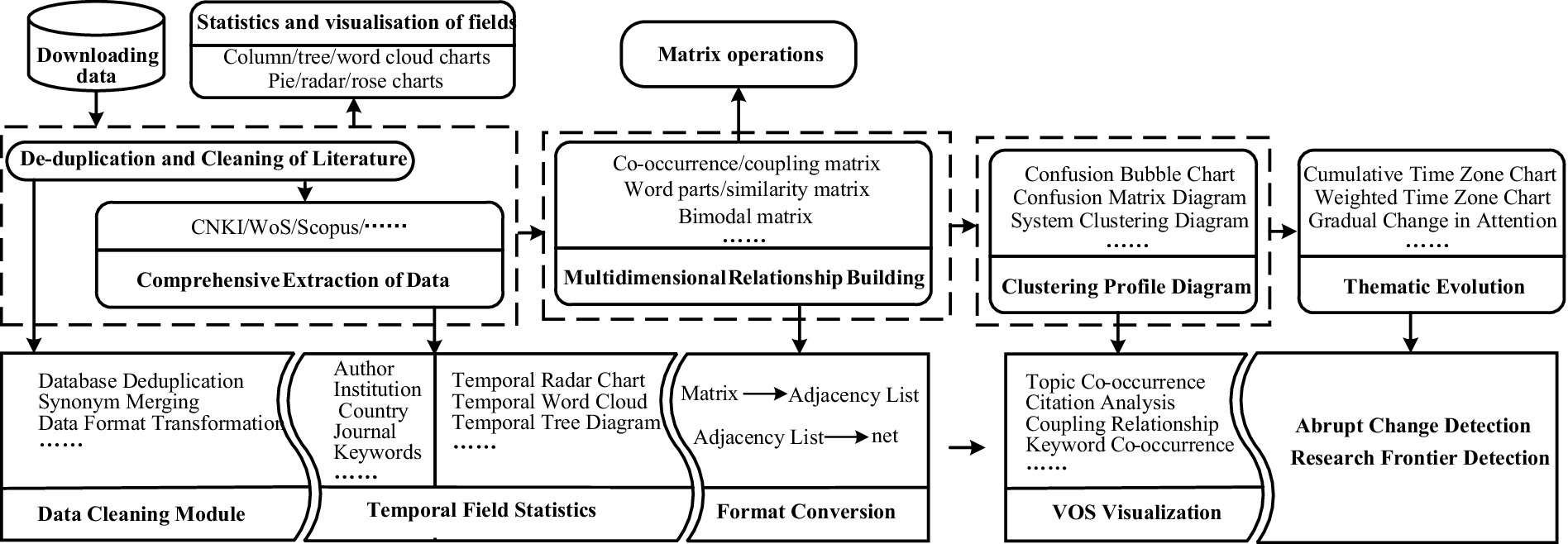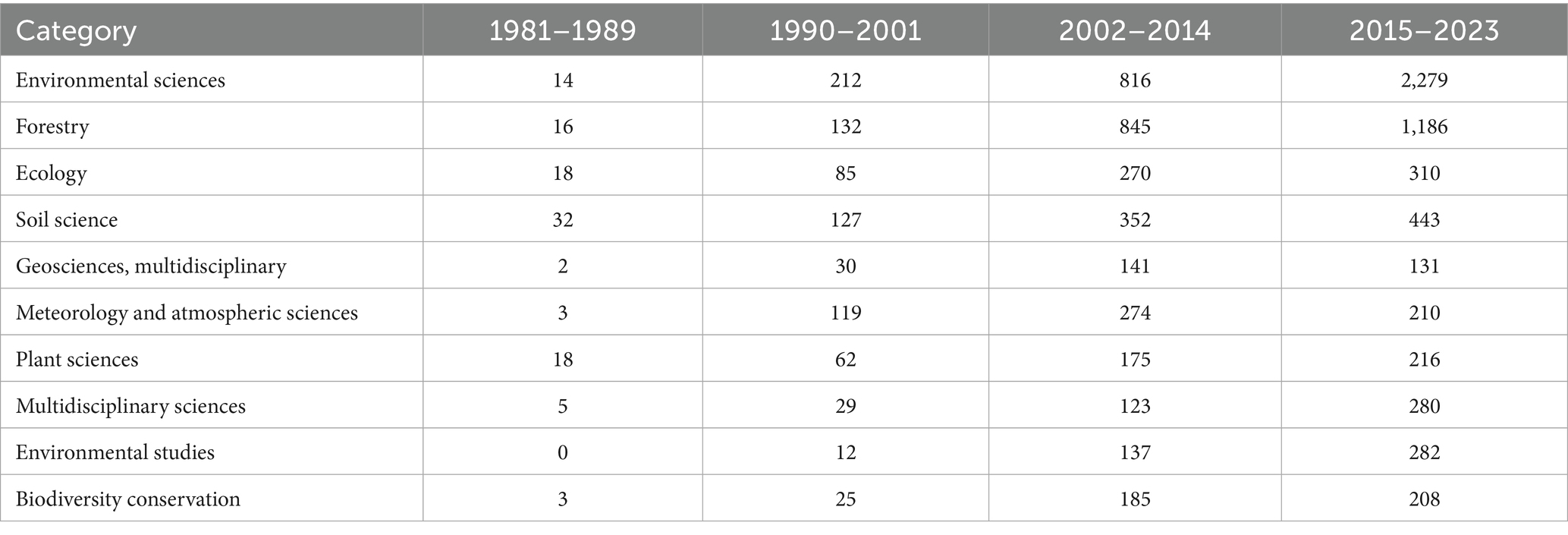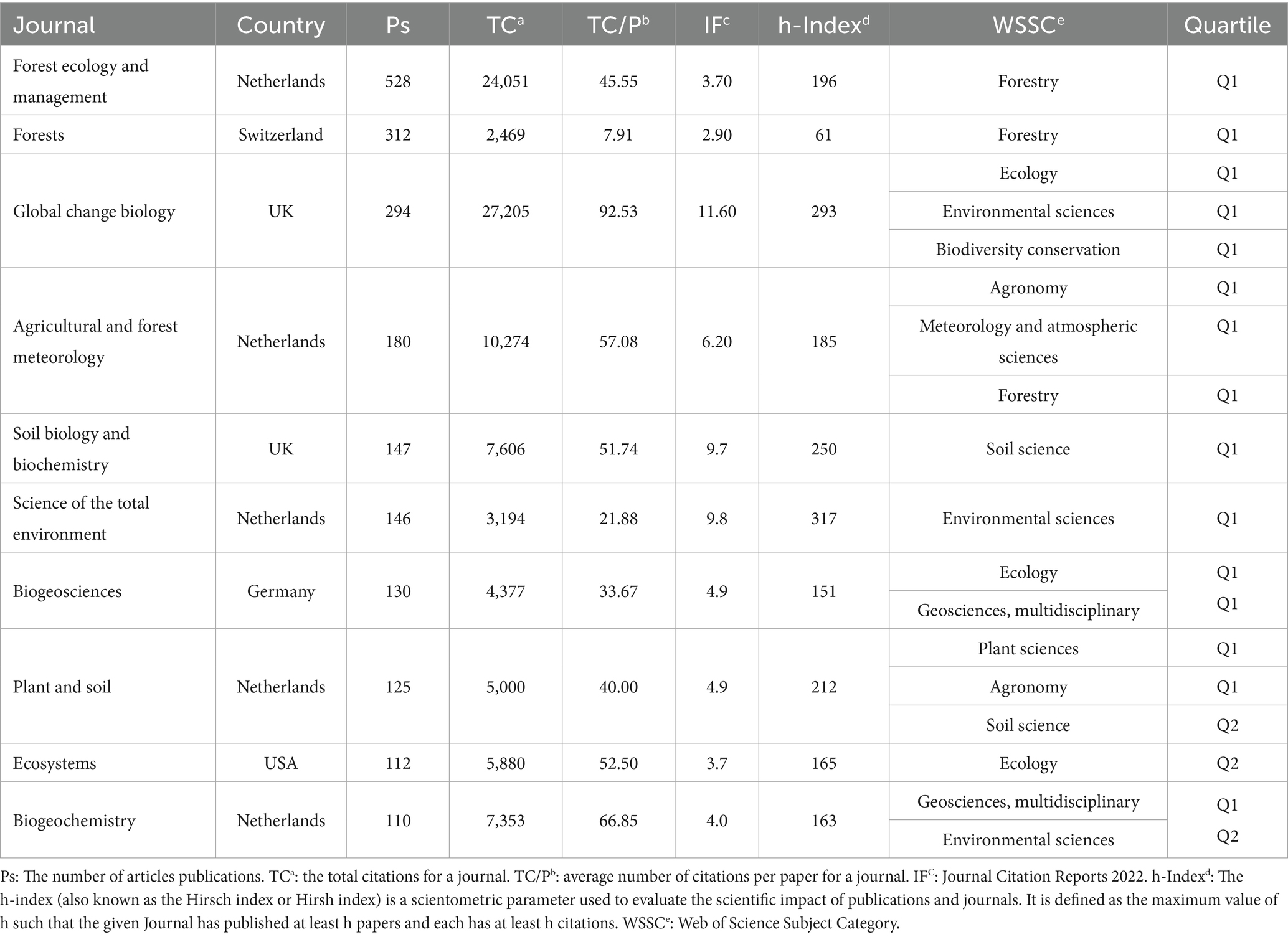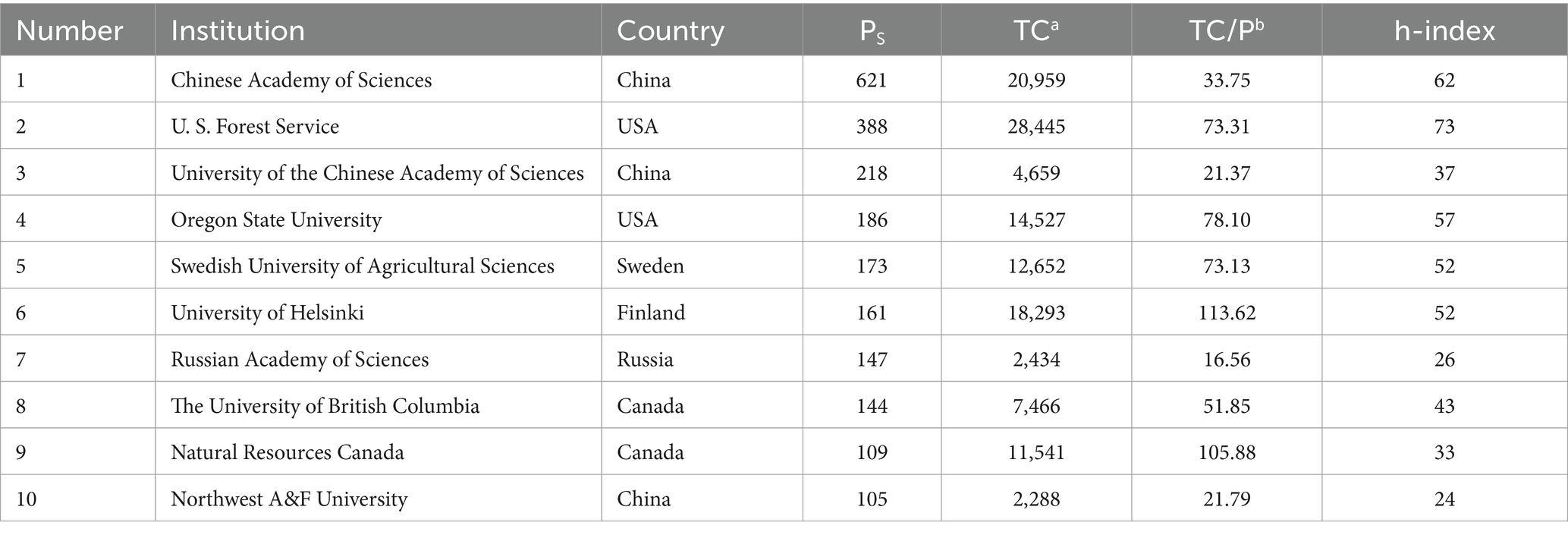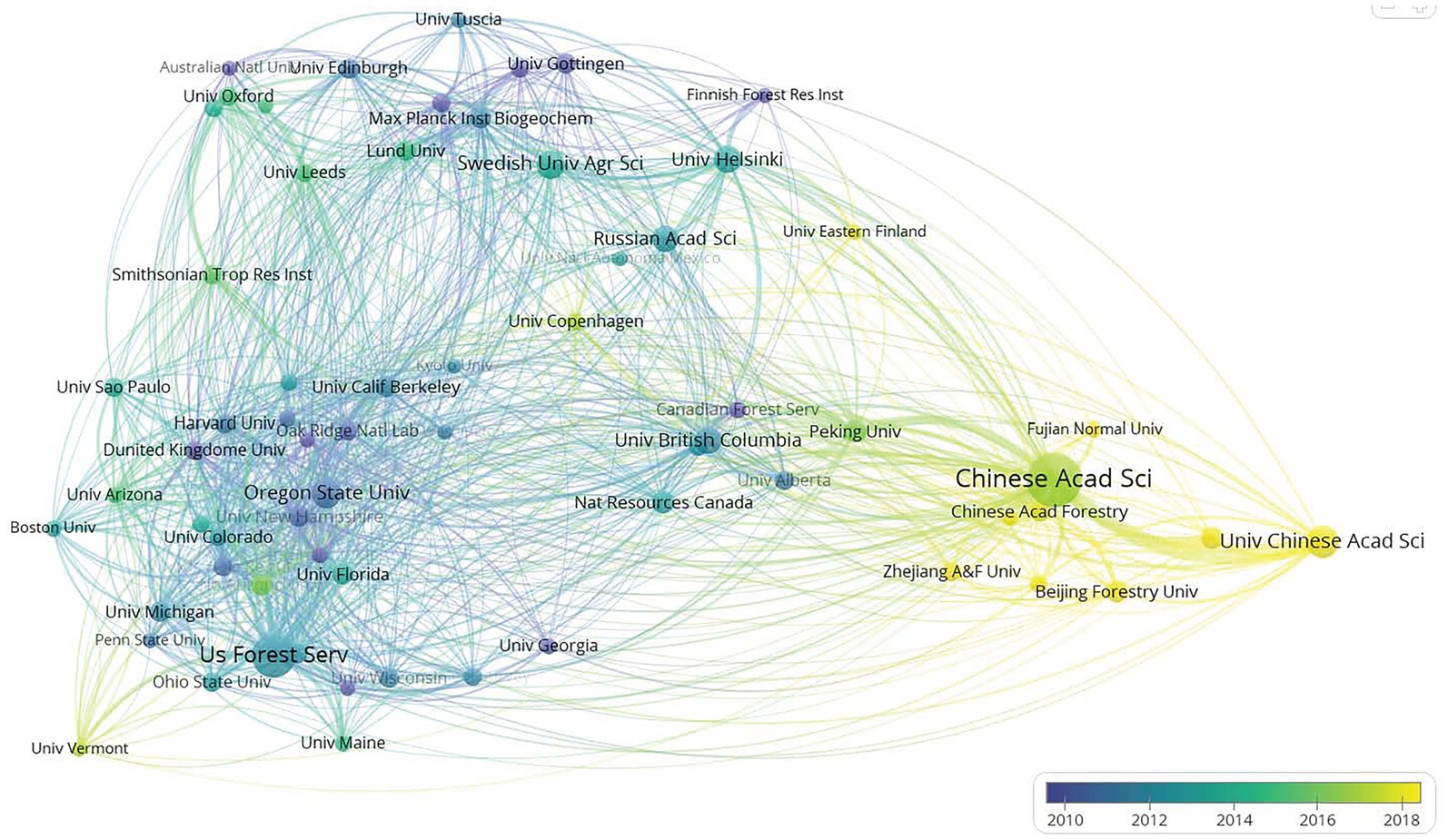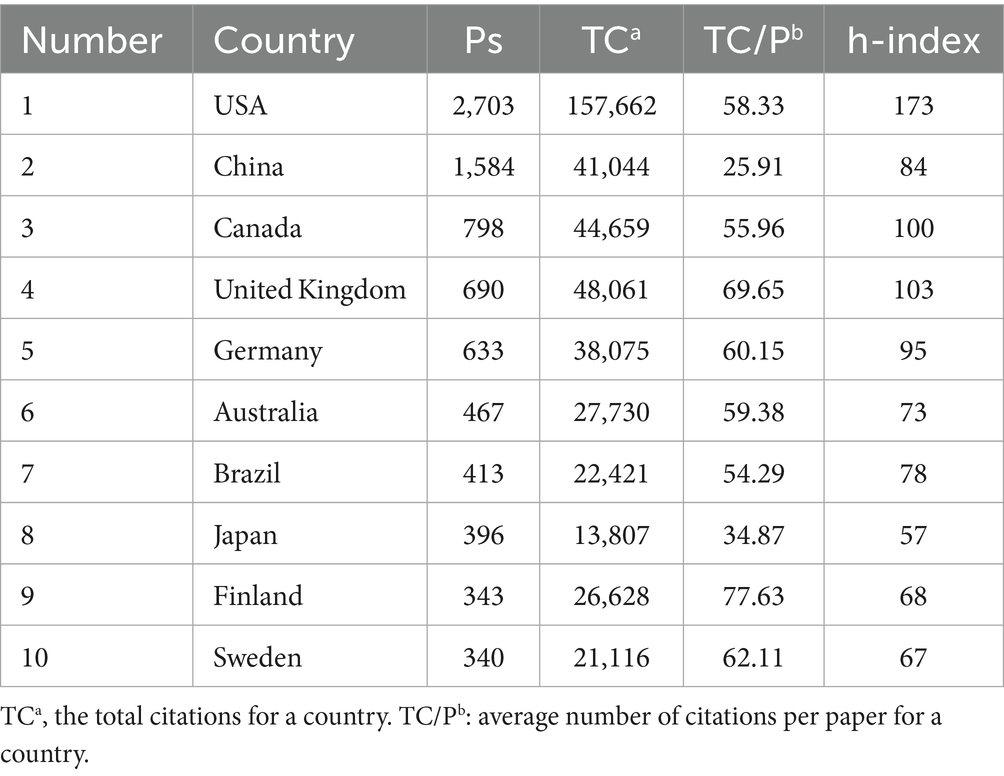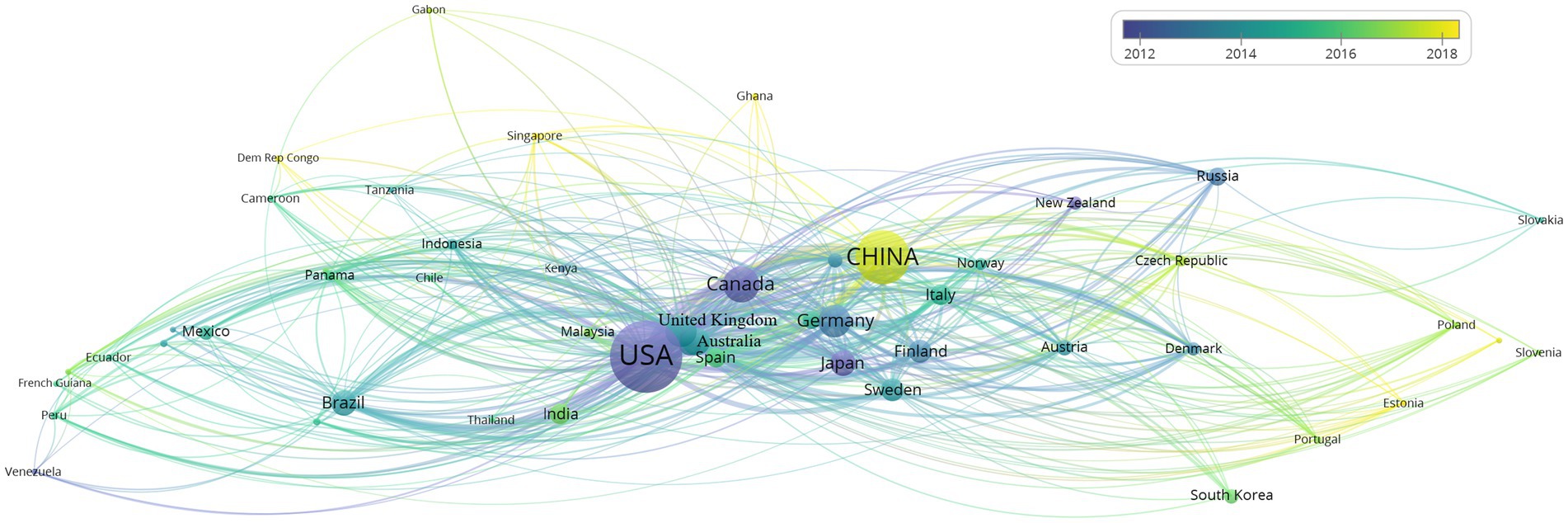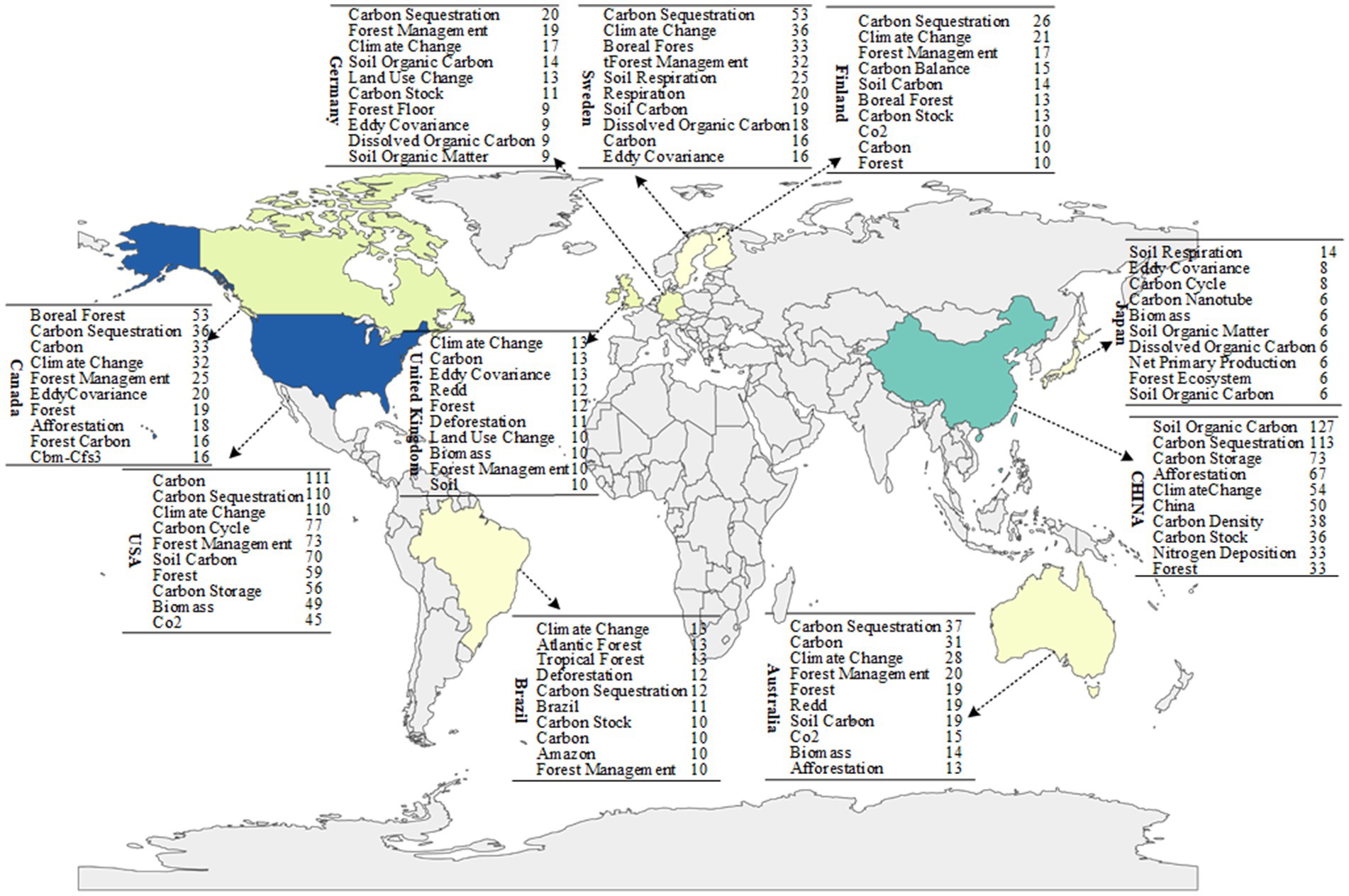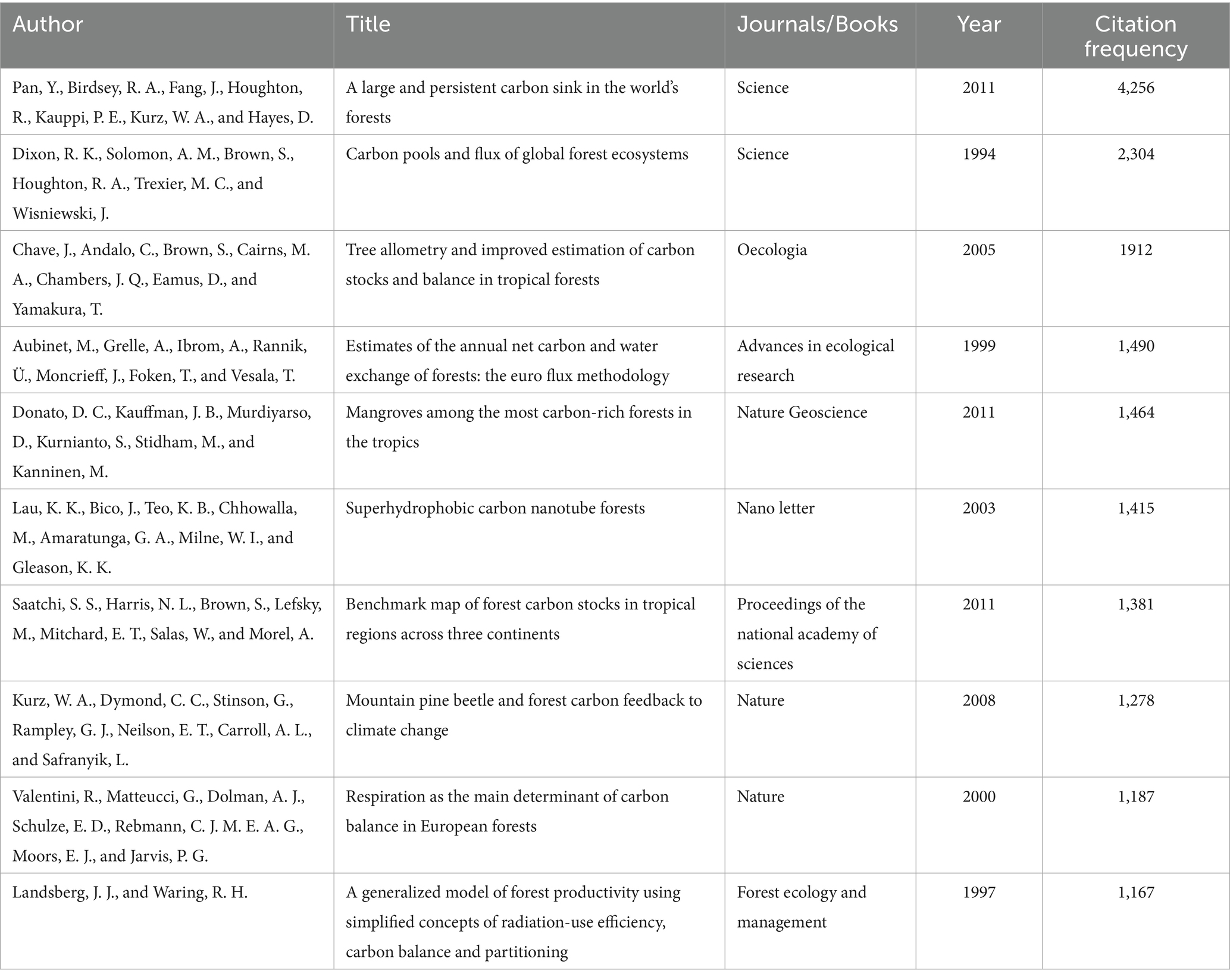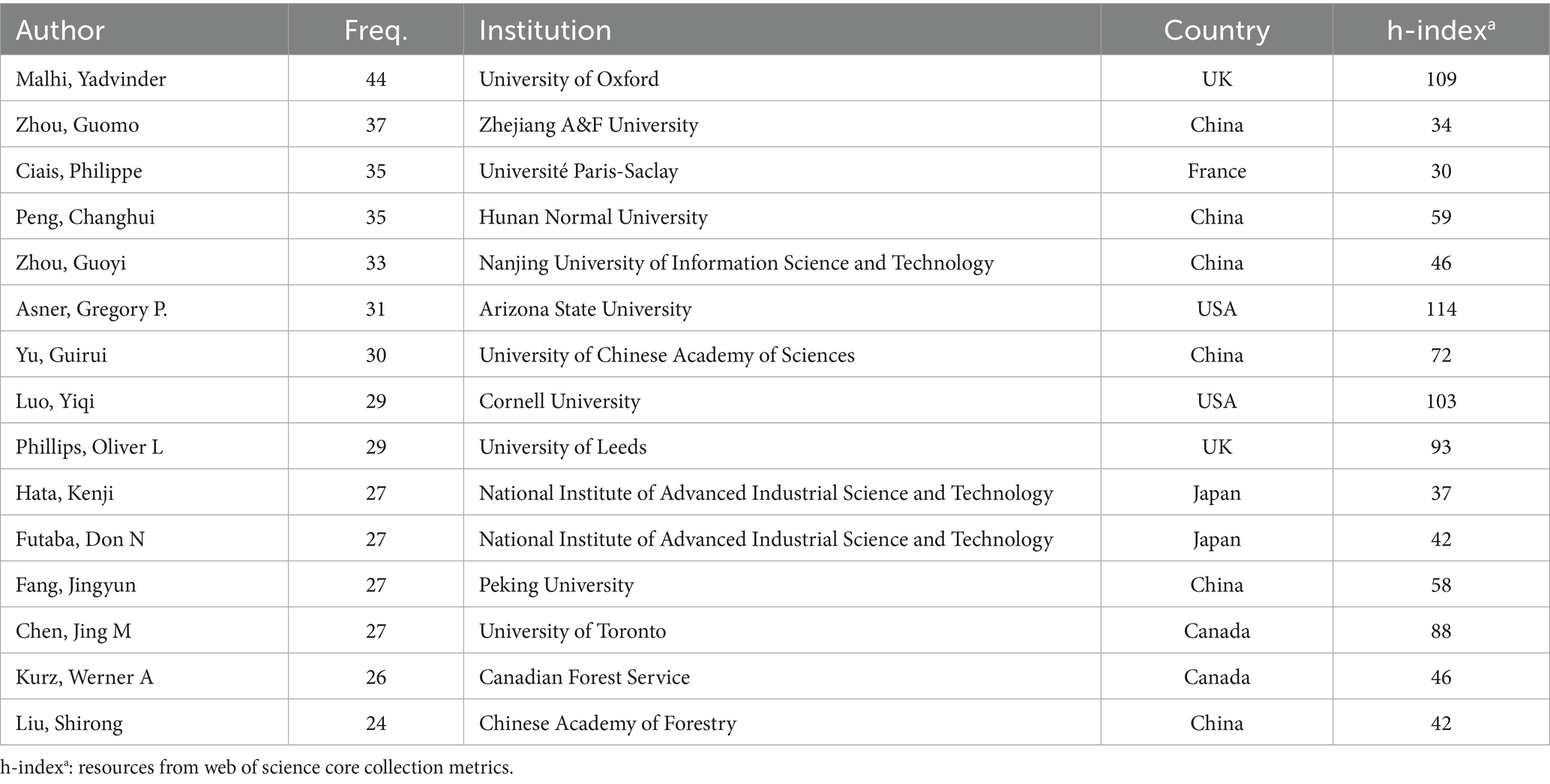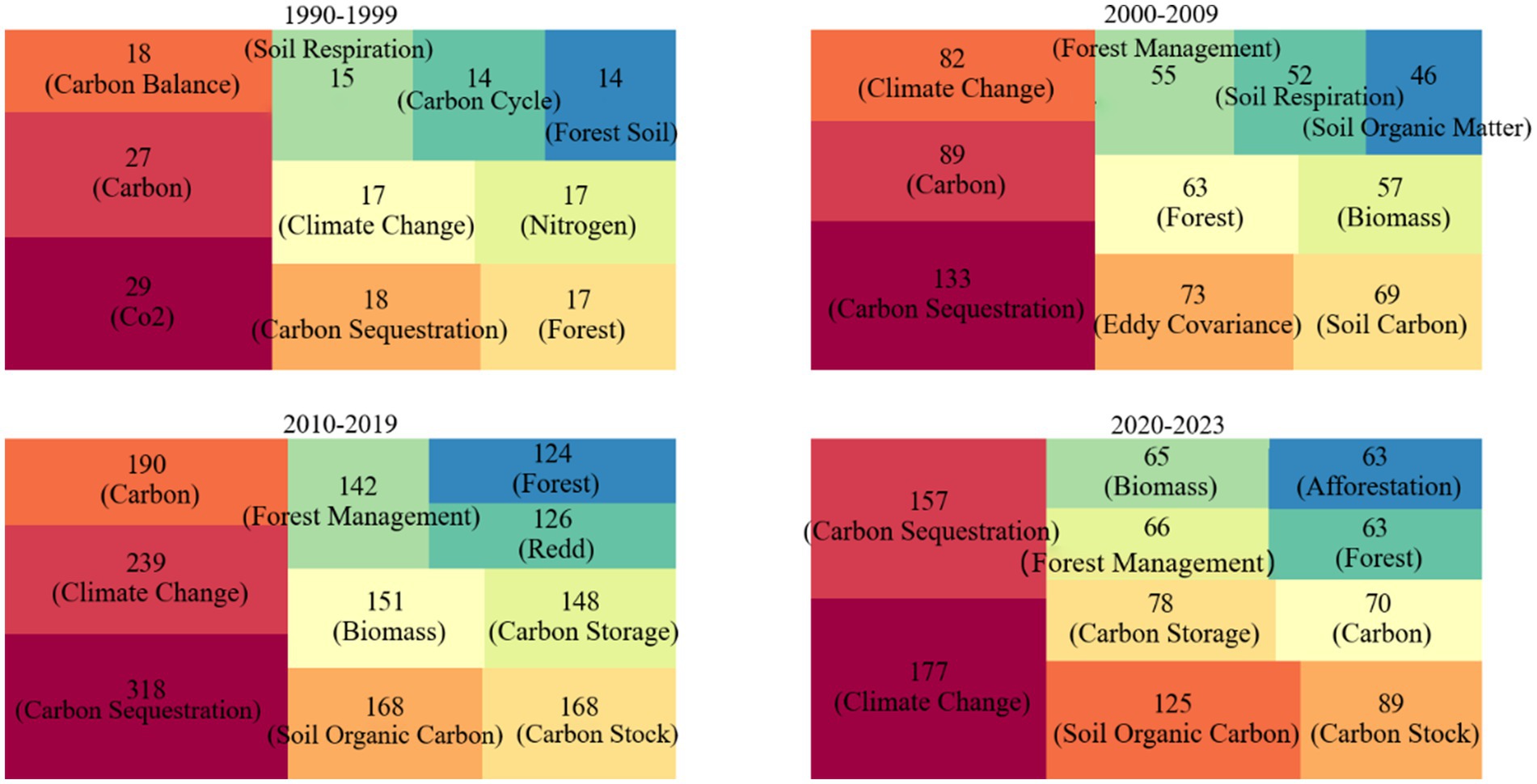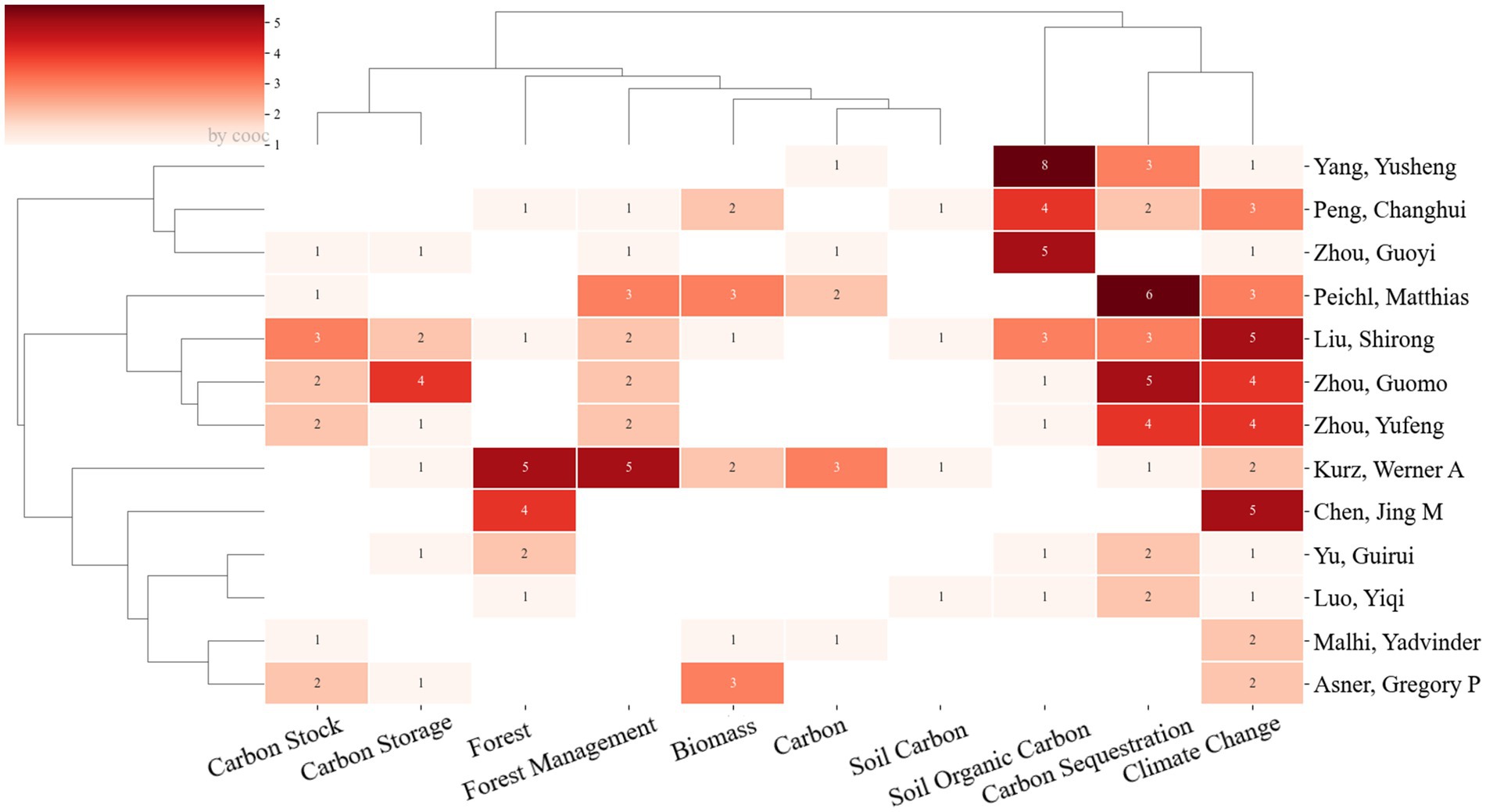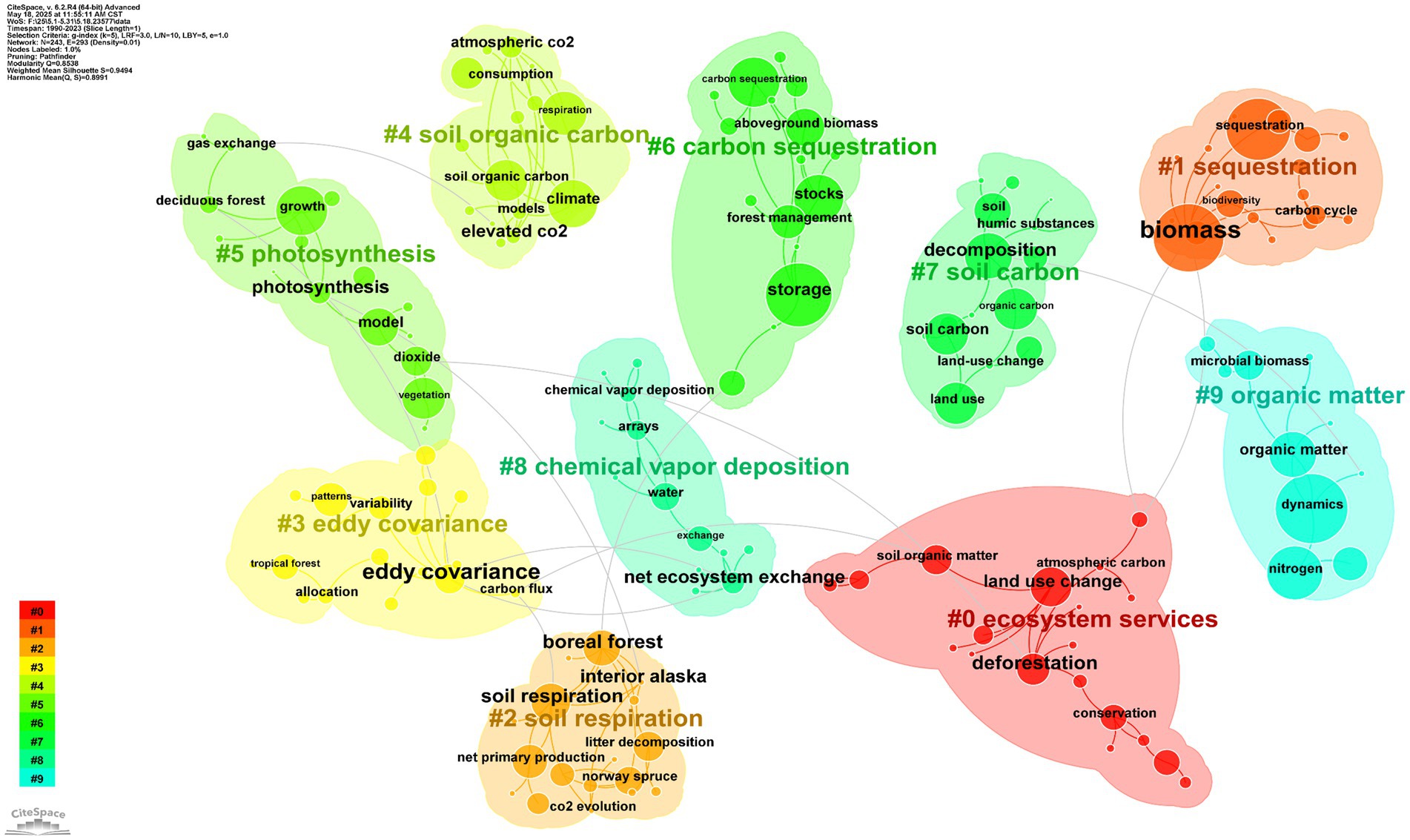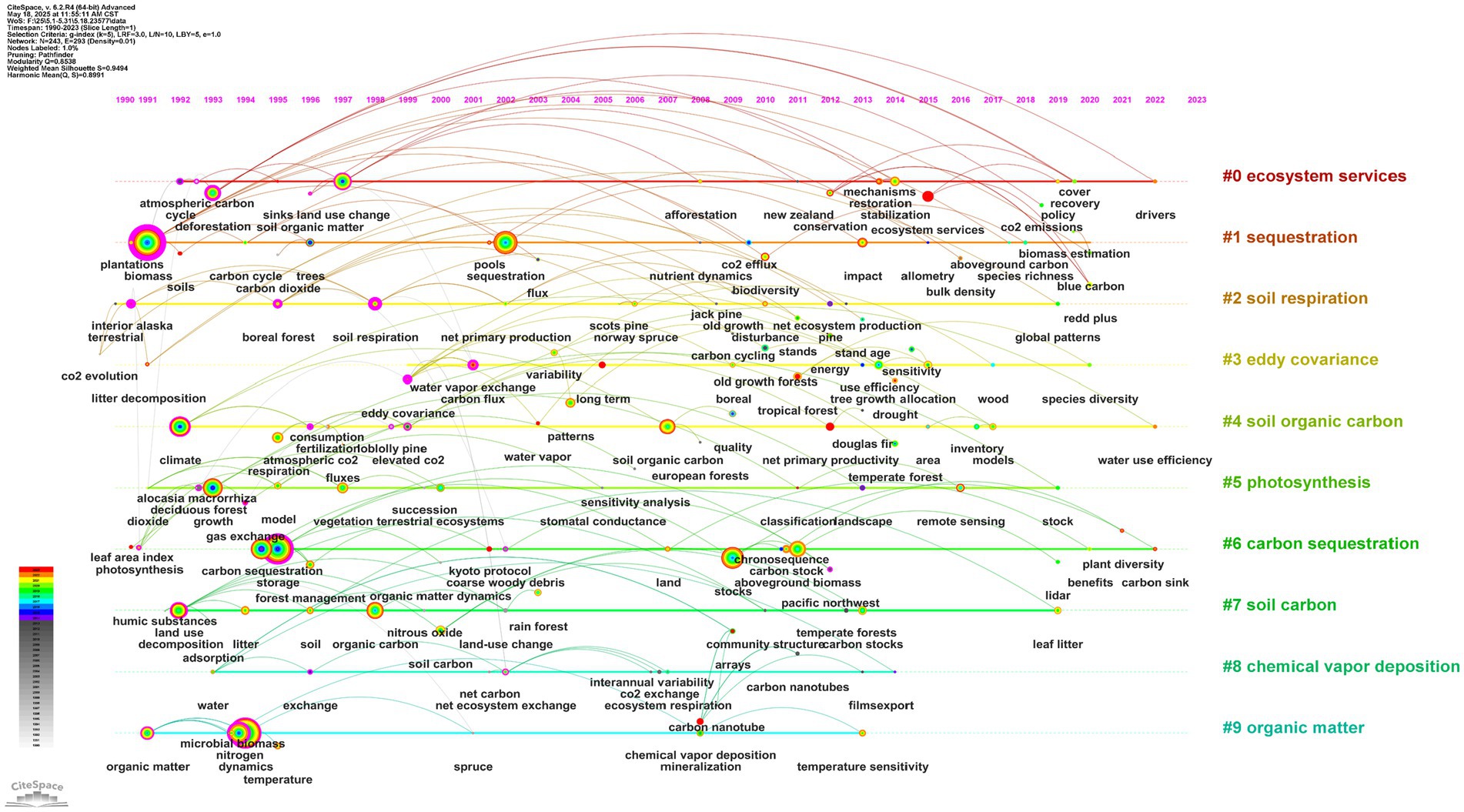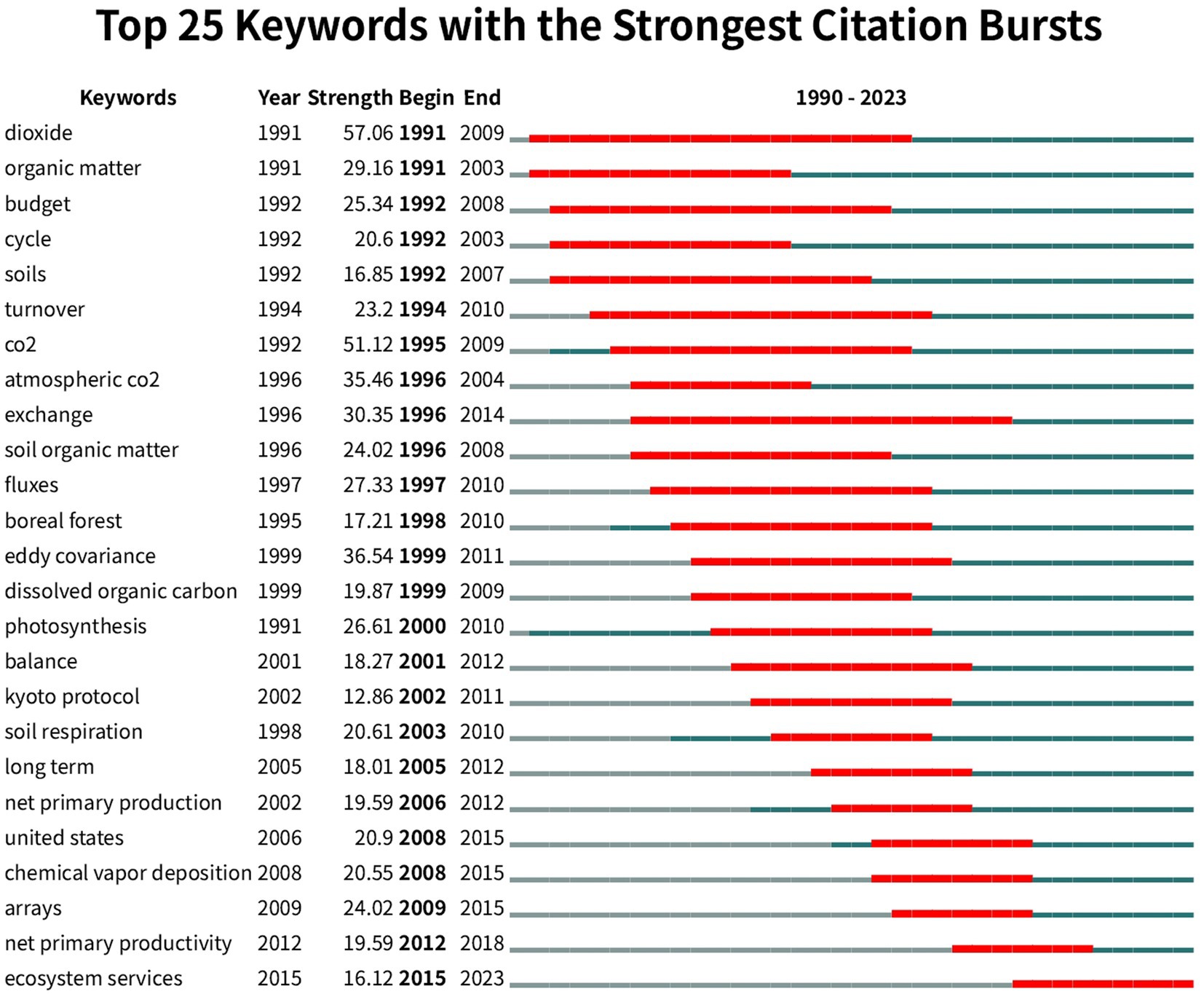- School of Civil Engineering, Zhengzhou University, Zhengzhou, China
Employing scientometric analysis of 8,346 peer-reviewed publications indexed in the Web of Science Core Collection (1981–2023) on climate change and forestry carbon sink, systematically elucidated fundamental dimensions encompassing developmental trajectories, disciplinary characteristics, and intellectual frameworks. The results of this study indicate the following: (1) the number of publications focusing on climate change and forestry carbon sink is exhibiting exponential growth, signifying a “Rapid development period” in this field. Forest Ecology and Management constitutes the predominant knowledge dissemination platform, while Environmental Sciences stands out as the most popular subject category. (2) The United States, China, and Canada are the most productive countries in terms of research output in this field. Additionally, the Chinese Academy of Sciences serves as a pivotal institutional entity in epistemological production conducting research in this area. (3) The seminal work, titled “A large and persistent carbon sink in the World’s forests” (Citations: 6,467) was authored by Pan, Y., a senior researcher affiliated with the U. S. Department of Agriculture (USDA) Forest Service. (4) The bibliometric keyword co-occurrence network analysis of keywords illustrates that climate change and forestry carbon sink remain the focal research topics in this field. It is observed that the research hotspot of climate change and forest carbon sink is transitioning from ecological dynamics to socio-economic systems research. Nonetheless, carbon reduction and carbon sink continue to be recognized as constituting essential components in the climate stabilization portfolio. Ultimately, drawing from the aforementioned analytical research, this paper suggests four prospective avenues for advancing the epistemic frontier.
1 Introduction
Since the Industrial Revolution, the uncontrolled activities of mankind have led to a continuous increase in the emission of greenhouse gases (GHGs), primarily carbon dioxide (CO2). This rise in GHG emissions directly triggers global warming, resulting in significant climate change (Bonan et al., 1992). It is crucial to note that climate change acts as a primary driver of forest degradation, particularly since 1850. During this period, the loss of forest cover has contributed to a 45 percent increase in atmospheric carbon dioxide emissions compared to previous levels (Malhi et al., 2002). Additionally, climate change serves as a significant catalyst for numerous adverse effects such as species migration, droughts, floods, glacier melting, reduction in snow depth, insect outbreaks, and forest fires (Allen et al., 2010; McKenzie et al., 2004; Mote et al., 2005; van Mantgem et al., 2009). These impacts have inflicted varying degrees of damage on natural ecosystems and human social systems. The Fifth Assessment Report of the Intergovernmental Panel on Climate Change (IPCC) emphasizes that even if humans were to cease emitting greenhouse gases, the associated impacts of climate change would persist for centuries (Pachauri et al., 2014). Consequently, protecting forest resources, mitigating the warming trend, and combating climate change have become critical issues for the international community.
To accelerate the global climate governance process, more than 150 countries and the European Union (EU) co-signed the United Nations Framework Convention on Climate Change (UNFCCC) during the United Nations Conference on Environment and Development (UNCED) in 1992. This convention established distinctions between the obligations of different countries and outlined procedures for their implementation, along with defining relevant concepts. The UNFCCC defines “carbon sinks” as processes, activities, or mechanisms that remove greenhouse gases (GHGs), aerosols, or GHG precursors from the atmosphere. Conversely, “carbon sources” refer to processes or activities that emit GHGs, aerosols, or GHG precursors into the atmosphere. Forest ecosystems, being a vital component of terrestrial ecosystems, act as significant carbon storage reservoirs on land. Forest soil carbon accounts for approximately 39 percent of global soil carbon stocks, while vegetation carbon stocks contribute to about 77–85 percent of global vegetation carbon stocks (Watson et al., 2000). Forests are crucial for mitigating the greenhouse effect and combating global warming due to their long-term and sustained enhancement of carbon sink capabilities (Cannell, 1996; Dixon et al., 1994; Wang et al., 2007). Furthermore, utilizing forests as carbon sinks are considered more cost-effective than emissions reductions (Obersteiner et al., 2001; Sohngen and Alig, 2000). With the ongoing negotiation process of the UNFCCC and the adoption and formal entry into force of the Kyoto Protocol, the international community has recognized and focused on the carbon sink function of forests. The Bonn Political Agreement and the Marrakesh Agreement subsequently incorporated forestry activities such as afforestation and reforestation into the Clean Development Mechanism (CDM) established by the Kyoto Protocol. This encouraged countries to offset a portion of their industrial CO2 emissions through greening and afforestation, thus laying the foundation for the international “Carbon Emission Trading System.” In 2015, the Paris Agreement was signed by 178 parties globally. It aimed to limit the increase in global average temperature to within 2°C compared with pre-industrial levels and strive to keep the increase below 1.5°C. China, as a significant contributor to and active practitioner of the Paris Agreement, announced its commitment to peak CO2 emissions by 2030 and achieve carbon neutrality by 2060 in response to climate change concerns.
Forestry carbon sink and forest carbon sink are closely related but distinct concepts. Forestry carbon sink refers to the process of forest plants absorbing and fixing atmospheric CO2 through photosynthesis, reducing CO2 concentration in the atmosphere (He and Ren, 2023). On the other hand, forest carbon sink encompasses activities such as afforestation, forest management, and protection, which utilize the carbon storage function of forests to absorb and fix atmospheric CO2 (Zhao et al., 2023). The forest carbon sink is integrated with carbon trading under relevant rules. While forest carbon sink focuses on the physical properties of forests to absorb CO2 and falls within the realm of natural science, forestry carbon sink includes economic properties related to reforestation and emphasizes human participation. It has a wider scope, encompassing social properties. Therefore, this paper primarily focuses on forestry carbon sink as the research object, aiming to comprehensively explain the research progress in this area.
In the 1980s, the United States took the lead in researching climate change and forestry carbon sink (Armentano and Ralston, 1980; Sedjo, 1989a; Sharpe and Johnson, 1981; Solomon, 1986; Woodwell et al., 1983), followed by the United Kingdom, the Netherlands, and other countries. After nearly half a century of development, research on the subject of carbon sinks in forestry has shown a complex and complicated trend, such as quantitative research on the carbon sequestration and storage capacity of forest (Goodale et al., 2002; Heinrich et al., 2021; Sedjo, 1989a; Alemu, 2014), research on valuation methods for forest carbon sink (Birdsey et al., 1993; Gibbs et al., 2007; Johnston and Withey, 2017), research on the ecological and economic benefits of forest carbon sink (Bhattacharyya et al., 2021; Lin and Ge, 2020; Schuppert, 2016; van der Gaast et al., 2018), research on the trading mechanism of forest carbon sink (Caplow et al., 2011; Kim et al., 2021; Miah, 2021; Michel et al., 2014; Verma and Ghosh, 2024), research on financing of forestry carbon sink (Boscolo et al., 2010; Fleischman et al., 2021; Jacobson et al., 2009; Peskett et al., 2011; Şen et al., 2019; Warkentin and Sodhi, 2008), and its research results are also endless.
Data collection forms the foundational basis for monitoring forest carbon sinks and carbon flux (Wang et al., 2022). Monitoring methods for forest ecosystems with spatiotemporal continuity can be categorized into two types: real-time monitoring (continuous observation over weeks) and non-real-time tracking (long-term flux monitoring spanning years or decades). Non-real-time approaches, such as inventory-based methods and system modeling and inference methods, do not provide immediate data but enable long-term trend analysis by reorganizing content into well-defined groupings. In contrast, remote sensing and atmospheric inversion are real-time monitoring techniques. While inventory-based methods are widely used in carbon cycling studies within forest ecosystems, they are labor-intensive and challenging to implement at scale (He et al., 2021; Wang et al., 2021). Systematic modeling and inference utilize methodological modeling frameworks and standardized non-parametric algorithms to predict forest carbon stocks and fluxes. These include: K-nearest neighbors (KNN), artificial neural networks (ANNs), random forests (RF), support vector machines (SVMs), and maximum entropy (MaxEnt) (Zhang et al., 2022a; Zhang et al., 2022b). Forest ecosystem monitoring methodologies can be categorized into two classes based on data acquisition approaches: top-down and bottom-up. Top-down measurements encompass remote sensing, atmospheric inversion techniques, ecological modeling, and the eddy covariance (EC) technique (Liu Q. et al., 2023; Liu P. et al., 2023). These methods utilize data collected from above or distant platforms to estimate carbon fluxes at broader scales, providing a macro-level understanding of ecosystem carbon cycles. The advent of freely accessible satellite data has popularized remote sensing technologies. Intensive temporal analysis has enhanced the quality and accuracy of remote sensing data, expanding detectable land surface changes. This approach addresses the limitations of eddy covariance (EC)-such as its reliance on meteorological towers and manual observations, low data accuracy, and insufficient temporal resolution (Gu et al., 2012; Khan et al., 2018; Wang et al., 2016). To investigate the spatiotemporal characteristics of CO₂ fluxes in forest ecosystems, remote sensing-based methodologies can be categorized into two primary approaches: Indirect Estimation Methods; These include forest biomass-based methods for quantifying carbon stocks and deriving CO₂ fluxes from temporal carbon stock variations. Such approaches focus on monitoring forest carbon pools to infer CO₂ uptake/release dynamics. Direct Monitoring Methods; Satellite-based observations: Utilizing meteorological satellites or dedicated greenhouse gas monitoring satellites to directly assess carbon exchange processes between forests and the atmosphere. Atmospheric inversion techniques: Estimating CO₂ fluxes by measuring atmospheric CO₂ concentrations and modeling transport/diffusion processes, providing top-down flux quantification at regional to global scales. The Eddy Covariance (EC) technique remains the gold standard for measuring Net Ecosystem Exchange (NEE) at the atmosphere-forest interface. However, its reliance on idealized assumptions (e.g., steady-state turbulence, and horizontal homogeneity) introduces uncertainties in storage flux estimations. To address these limitations, advancements include: energy-based turbulent flux correction methods (AEC) (Zhang et al., 2024). Spatiotemporal representativeness studies (Fang et al., 2024), and Artificial tracer release systems to minimize measurement biases through controlled emission adjustments (Liu S. et al., 2024). Furthermore, these methodologies can be classified according to monitoring timeliness and real-time detection approaches, such as chamber methods, the eddy covariance (EC) method, remote sensing, isotopic techniques, chemical flux methods, and atmospheric inversion techniques, all of which generate real-time data to characterize the current status of carbon fluxes. Conversely, researchers employ diverse bottom-up methodologies (e.g., dendrochronological and inventory methods, isotope techniques, chemical flux methods, and chamber methods) to enhance the precision of CO₂ flux quantification and monitoring (Yona et al., 2020), these approaches rely on ground-level forest data collection, prioritizing granular measurements at localized scales.
Although the importance of carbon sinks in forestry is increasingly recognized, and many scholars have conducted in-depth studies, there is a lack of attention to the progress and development trends in this field. Some studies have focused on specific aspects of forestry, such as vegetation, soil, or biology, while others have provided empirical or qualitative (quantitative) analyses limited to specific topics like geographical areas, stages, disciplines, ecosystems, and so on (Heinrich et al., 2023; Liu Q. et al., 2023; Liu P. et al., 2023; Makkonen et al., 2015; van Kooten and Sohngen, 2007). Existing literature reviews often struggle to grasp key threads and effectively summarize and analyze the development process in this specific field (Huang et al., 2020a). In particular, forestry carbon sink are cross-disciplinary, encompassing Forestry, Environmental Sciences, Ecology, Economics, Management, Plant and Animal Conservation, Geographic Information Science, Atmospheric Science, and other disciplines (Huang et al., 2020a). The studies conducted similar analyses based on statistical results (authors, keywords, evolutionary analysis, etc.), and through data mining and information processing, they explored the relationships between different disciplines to accurately grasp the research trends and directions in the field. Exploring the answers to these questions is of great practical significance for a comprehensive understanding of the field of forestry carbon sink.
Bibliometrics, initially focused on publications and citation analysis (Andrés, 2009; Haddow, 2013), has evolved to include journals/articles, books, and reports as major data sources. This approach utilizes statistical and computational techniques to quantitatively and qualitatively analyze database resources, providing insights into the state of research within a given field, its characteristics, and trends (Aleixandre-Benavent et al., 2017; Mourão and Martinho, 2020); After that, traditional bibliometric citation analysis is combined with information visualization technology, through text mining, information processing, scientific measurements, and graphic drawing, to visually present the structure, law, and distribution of scientific knowledge in a certain discipline or field in the form of knowledge mapping, to show the current status of the research within a certain period and trend, and to predict the future development trend of the field (Shiffrin and Börner, 2004). Bibliometric analysis methods have been widely used in various fields as they provide innovative perspectives on research trends at the macro level (Ellegaard and Wallin, 2015; Wang et al., 2018). In recent years, bibliometrics has been increasingly used in studies related to climate change and forestry carbon sink; Aleixandre-Benavent clustered the literature on deforestation using the bibliometric software VOSviewer to gain insight into the interactions between deforestation and climate change (Aleixandre-Benavent et al., 2018); Based on the journals and articles on the Web of Science Core Collection, Huang L conducted a scientometric analysis of the literature related to forest carbon sink to identify and reveal the basic characteristics, research strength, knowledge base, and research hotspots in this field (Huang et al., 2020b); Zhang Z revealed the research progress and the evolution of research hotspots in the field of “carbon neutrality” through quantitative analysis, pointing out that low-carbon development is the prerequisite for carbon neutrality, and emission reduction and carbon sinks are the basis for carbon neutrality (Zhang et al., 2022a; Zhang et al., 2022b). This investigation employs distinct bibliometric and visualization software, differing from those conventionally used, and also adopts an inductive analytical framework by superimposing keyword co-occurrence metrics onto geopolitical categorization of core nation-states, coupled with decadal-scale temporal segmentation of lexical frequency patterns. The methodological synthesis enhances the informational dimensionality of graphical representations, thereby enabling precise delineation of evolutionary trajectories within the research domain.
To systematically and objectively synthesize the research on climate change and forestry carbon sink, this study adopts the scientometric analysis method based on Co-Occurrence 13.7 (COOC13.7) to analyze the bibliometric characteristics of the papers in this field included in the core database of the Web of Science (from 1981 to 2023), and to show the visualization of their Correspondence. The objectives of this study include: (1) to determine the basic characteristics of the literature, such as the number of papers and citations, the classification of research topics, and the representative journals; (2) to determine the research output and contribution within the research field, such as the representative countries, institutions, and authors; (3) to analyze the analysis of the keywords’ clustering and evolution characteristics; (4) to assess the trends and shifts in research topics and directions over time.
2 Data collection and methods
2.1 Data collection
Bibliometric studies commonly utilize popular bibliographic databases such as Scopus, Web of Science, PubMed, and Google Scholar (Falagas et al., 2008). Among these, the Thomson Reuters Web of Science Core Collection stands out as a leading citation database globally. It encompasses over 12,000 influential academic journals, enjoying widespread recognition and authority within the international academic community (Mongeon and Paul-Hus, 2016). These journals encompass reputable international publications focused on climate change and forestry carbon sink. Consequently, this study employs the “Web of Science Core Collection” as the targeted database, incorporating the Science Citation Index Expanded and the Social Sciences Citation Index. To minimize irrelevant search outcomes, the query is confined to the “title” field, omitting the “subject” option, The search terms used include TI = (forest* AND “carbon sink”) OR TI = (forest* AND “carbon storage”) OR TI = (forest* AND “carbon sequestration”) OR TI = (forest* AND “carbon accumulation”) OR TI = (forest* AND “carbon”) OR TI = (afforestation* AND “carbon”). The search span encompasses all years from 1981 to 2023, with the search conducted at 16:30 on 29 Nov. 2023 (Beijing time). To ensure keyword standardization, synonymous terms and variations such as singular/plural forms and acronyms/derivatives are grouped. The search yielded 8,361 literature records, which were subsequently refined, resulting in a final set of 8,346 papers relevant to this research domain. The downloaded literature records were converted to plain text format and designated as the “literature database” for subsequent data analysis in this article.
2.2 Methods of bibliometric analysis
The predominant bibliometric visualization tools encompass CiteSpace, BibExcel, and VOSviewer. These platforms facilitate the clustering of scholarly corpora, generating multidimensional knowledge integrating thematic, terminological, and geopolitical dimensions. This investigation employs the Co-Occurrence13.7 (COOC13.7) analytical framework to conduct a transnational bibliometric examination of climate change and forest carbon sequestration research spanning 1981–2023. The COOC13.7 architecture demonstrates computational superiority in the comprehensive construction of multi-dimensional relationships, robust functionality, and user-friendly operation. Beyond core descriptive analytics with cluster dendrogram visualization, this analytical framework enables systematic investigation of disciplinary focal points and their paradigmatic shifts through temporal scientometric mapping.
The computational workflow was implemented on Microsoft Windows 10 Professional (64-bit architecture) using COOC13.7, Data extraction involved batch processing of Web of Science Core Collection records encoded text files. Subsequently, the aggregated datasets were merged and labeled as the “research database.” Figure 1 illustrates the research program and methodology employed in this study. All literature cited in the article is sourced from the Web of Science (WoS) database. To ensure the quality of the referenced articles, the search parameters are set to include only the “Web of Science Core Collection.” Keywords are entered based on the research topic. Due to the limitation of the WoS database, which allows for a maximum of 500 articles to be downloaded at a time, multiple downloads and subsequent merging are required for the articles in the study. Given the extensive period of this research, partial metadata fields exhibited incompleteness such as keywords or authors. Therefore, it is necessary to deduplicate and clean the literature to ensure the validity of the necessary information. Multivariate visualization matrices were generated encompassing terminological co-occurrence networks, contributor collaboration graphs, and institutional impact heatmaps. Through the evolution analysis of keywords, the research frontier and direction of the field can be described.
3 Data analysis
3.1 Basic characteristics of literature
3.1.1 Annual and cumulative number of publications
Changes in the annual publication count serve as indicators of the developmental trends and knowledge accumulation within the field of climate change and forestry carbon sink research. As depicted in Figure 2, spanning the years 1981 to 2023, the number of publications per year and the cumulative publication count in the WoS database exhibit a consistent upward trajectory. In terms of quantity, three notable turning points emerge in the publication of research on climate change and forestry carbon sink. The first turning point occurred in 1989 when the cumulative annual publication count surpassed 100 for the first time. The second turning point transpired in 2001, marking the initial instance where the annual publication count exceeded 100. Lastly, the third turning point emerged in 2014, with both the annual publication count and cumulative publication count surpassing 400 and 4,000, respectively. To facilitate comprehensive comparisons across periods, we have categorized the research on climate change and forestry carbon sink into four distinct stages.
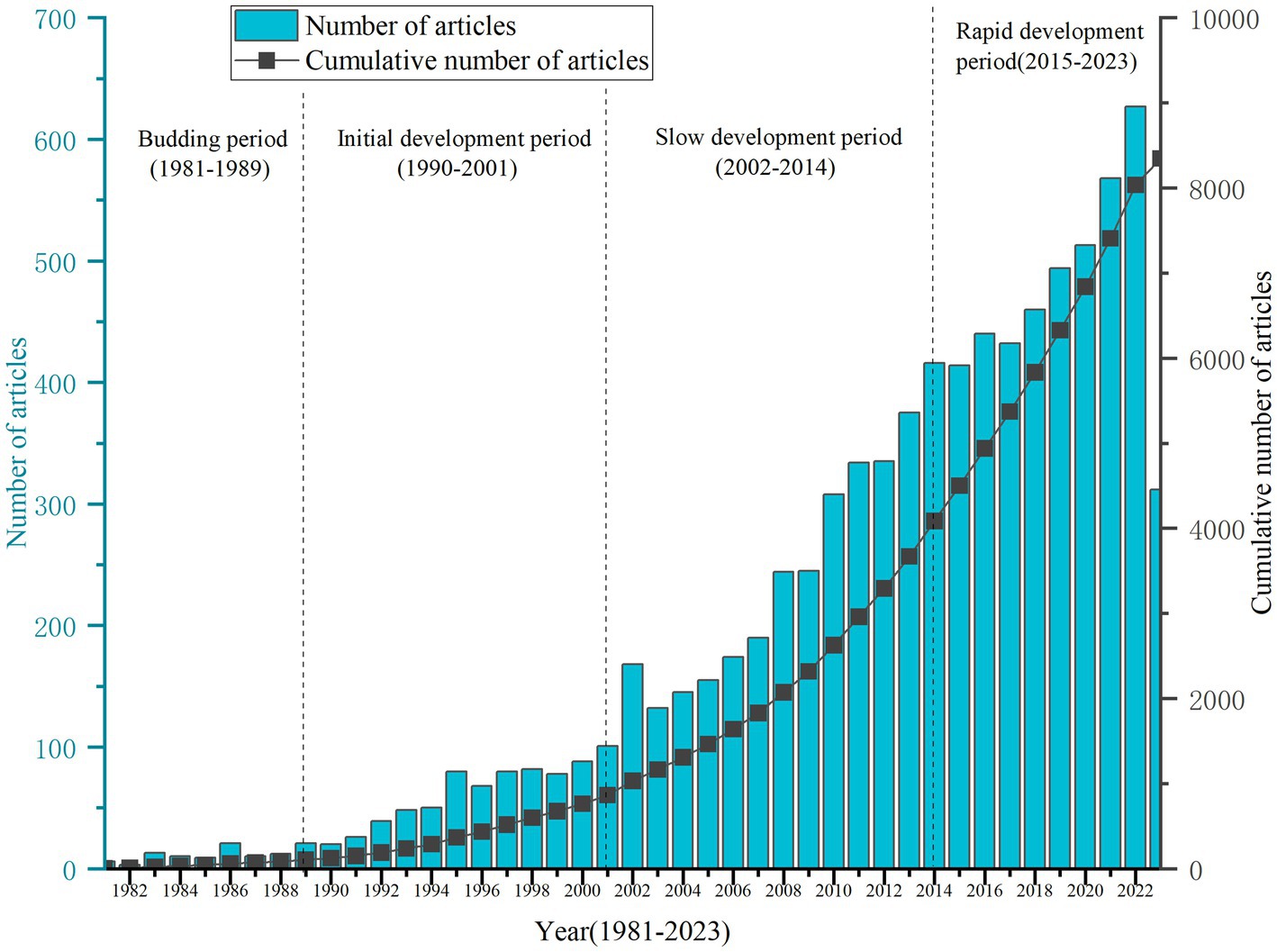
Figure 2. Statistics on annual and cumulative annual publications in the database of WoS (1981–2023).
Budding period (1981–1989): during this phase, a total of 105 papers were published, constituting approximately 1.26% of the overall number of papers (8346), with an annual average of 12 papers. While scholars had initiated research on climate change and forestry carbon sink, the limited quantity of articles can be attributed to the prevailing scientific, technological, and external environments of that era. Consequently, the content of these papers primarily concentrated on specific aspects, and the progress of related disciplines was relatively gradual.
Initial development period (1990–2001): during the initial development period, a total of 760 papers were published, accounting for approximately 9.11% of the overall volume. In the early 1990s, as climate change intensified and research deepened, some scholars (Sedjo, 1989b; Kauppi et al., 1992) started investigating the methodology for valuing carbon sinks in forestry. This research gained significant attention. However, due to the nascent stage of this field and limited researcher involvement in climate change impacts, the available literature during this period was relatively scarce. One notable research paper from this time is Landsberg and Waring (1997) proposal of the stand growth model: Physiological Processes Predicting Growth (3-PG). This model employs physiological principles to predict the growth process of forest trees, calculate the total amount of fixed carbon, and analyze forest growth and its underlying causes. Nevertheless, it requires corrections for effective photosynthetic radiation values due to soil conditions and atmospheric limitations. Additionally, being an ecological analysis tool, the model relies on weather data, soil conditions, and stand characteristics. It can also utilize the leaf area index for remote sensing estimation. Practical tests have demonstrated the model’s valuable application (Landsberg and Waring, 1997).
Slow development period (2002–2014): during the slow development period, there was a gradual increase in research results. The number of published articles consistently rose each year, with an annual average increase from 168 to 416 papers, totaling 248. Notably, two research papers emerged as representatives, both garnering citation frequencies exceeding 1,000 in the Web of Science (WoS). Chave et al. (2005) emphasized that tropical forests store substantial carbon reserves, yet their quantitative contribution to the global carbon cycle remains uncertain. To address this, Chave proposed a regression model that converts inventory data into estimations of aboveground biomass. However, the accuracy of this model is influenced by factors such as trunk diameter, wood-specific gravity, total height, and forest type (dry, moist, or wet). The model’s reliability hinges on the richness of the dataset (Chave et al., 2005). In another significant study, Saatchi et al. (2011) employed a combination of forest structural samples, including satellite detection, laser radar, and optical and microwave imagery, to estimate carbon stocks. This comprehensive approach resulted in a “baseline” map representing biogenic carbon stocks at the turn of the 21st century, encompassing over 2.5 billion hectares of forests across three continents. These estimates provided reliable data concerning carbon stocks in 75 developing countries, contributing to the implementation of REDD policies (Saatchi et al., 2011).
Rapid development period (2015-present): Since 2015, there has been a rapid and substantial increase in the number of published articles, indicating a sustained high growth rate. From 2015 to 2022, an average of 473 articles were published per year, with an impressive average annual growth rate of 8.55%. Numerical analysis suggests that research on climate change and forestry carbon sink is currently experiencing a significant upward trend, demonstrating immense potential for further development.
3.1.2 Subject category analysis
Table 1 presents an analysis of the article output of the top 10 subject categories. Environmental Sciences lead with 2,279 articles, accounting for 27.31% of the total, followed by Forestry with 2,179 articles (26.11%), Ecology with 683 articles (8.18%), Soil Science with 954 articles (11.43%), Geosciences, Multidisciplinary with 304 articles (3.64%), Meteorology and Atmospheric Sciences with 606 articles (7.26%), Plant Sciences with 471 articles (5.64%), Multidisciplinary Sciences with 437 articles (5.24%), Environmental Studies with 431 articles (5.16%), and Biodiversity Conservation with 421 articles (5.04%). Furthermore, based on the annual and cumulative number of publications and the stage division of related research, this section is divided into four time periods: 1981–1989, 1990–2001, 2002–2014, and 2015–2023.
The volume of publications in different disciplinary categories reflects trends in forestry carbon sink research. In a cross-sectional comparison, eight out of the top 10 disciplines experienced varying degrees of growth in combined publications during Stages I-IV (1981–2023). Particularly, Environmental Sciences and Forestry exhibited significant increases in publication volume, indicating rapid development within their respective disciplines. Conversely, other disciplines such as Ecology, Soil Science, Plant Sciences, and Biodiversity Conservation displayed slower growth. The volume of publications in some disciplines, such as Geosciences, Multidisciplinary, and Meteorology and Atmospheric Sciences, decreased during Stage IV (2015–2023), partly due to incomplete article counts in 2023 (as of 16:30 29 November 2023), and partly due to a decrease in research intensity.
In terms of longitudinal periods, Stage I (1981–1989) and Stage II (1990–2001) witnessed a relatively low and gradual growth in the volume of publications. Scholars’ focus gradually shifted from Soil Science (Stage I) to Environmental Sciences (Stage II) and Forestry (Stages III and IV). This shift reflects the growing recognition among mankind regarding the pivotal role of forests in combating climate change. Notably, during Stage IV (2015–2023), there was a significant surge in the volume of publications within the disciplines of Environmental Sciences and Forestry. Additionally, Environmental Studies has emerged as a noteworthy area of research, receiving sustained attention from scholars across various fields.
Climate change and forestry carbon sequestration research encompass a broad range of disciplines and intricate research topics. In this paper, we employ VOSviewer, a visual tool, to classify the disciplines involved (as depicted in Figure 3). In the visualization, nodes represent specific disciplines, node size corresponds to the output of each discipline, colors denote clusters formed by different disciplinary collaborations, connections between nodes showcase knowledge links across disciplines, and line thickness indicates the strength of these connections. The primary disciplines engaged in this research area include Environmental Sciences, Forestry, Ecology, Agronomy, Soil Science, and Multidisciplinary Science. Environmental Sciences exhibits close associations with other disciplines, particularly Ecology and Forestry. Agronomy serves as an intermediary node, demonstrating strong connections with Soil Science and Plant Science. Overall, research on climate change and forestry carbon sink has predominantly focused on four key areas: Environmental Sciences, Ecology, Agronomy, and Forestry.
3.1.3 Journal analysis
In this paper, a total of 8,361 documents were obtained after the initial merging, screening, and elimination processes. The search results identified 905 journals that published studies on climate change and forestry carbon sink between 1981 and 2023. Table 2 presents the top 10 journals based on the number of publications in this field. Forest Ecology and Management tops the list with 528 publications, followed by Forests with 312 publications and Global Change Biology with 294 publications. Notably, each of these journals has published over 200 articles related to climate change and forestry carbon sink.
In general, the number of citations (TC) received by a paper serves as an indicator of its impact. However, it is important to consider that the impact of a journal can vary across different fields of study. To assess the relative importance of a journal within a specific field, the average number of citations per paper (TC/P) is used as a reliable measure (Ji et al., 2014). Additionally, the Impact Factor (IF) provides a means to gauge the relative significance of a journal in its field (Garfield, 2006); Furthermore, the h-index serves not only as an indicator of authors’ scientific productivity and impact but also allows for the assessment of a journal or country’s influence in a particular field (Zhao and Li, 2015). Table 2 reveals that the Journal of Global Change Biology exhibits maximum values for TC (27205), TC/p (92.53) and IF (11.60), while the Journal of Science of The Total Environment boasts the highest h-index (317). Despite Forest Ecology and Management having the highest cumulative number of articles (528), its TC, IF, and h-index are smaller compared to those of Global Change Biology. Thus, from a personal perspective, Global Change Biology holds more influence than Forest Ecology and Management in climate change and forestry carbon sink research. Furthermore, the TC/P of Global Change Biology is more than twice as high as that of Forest Ecology and Management. Although Global Change Biology publishes fewer relevant articles, its citation rate is higher, indicating a relatively high level of article quality.
In terms of the disciplinary classification of journals, the top 10 journals encompass various fields, including Forestry, Agronomy, Ecological Sciences, Geosciences, Soil Sciences, and others. This wide range of disciplines indicates the interdisciplinary nature of research on climate change and forestry carbon sink. It also reflects the systematic and complex nature of this research. Regarding journal rankings, all the listed journals belong to Quartile 1, except for Soil Science (a secondary discipline under Ecosystems and Plant and Soil) and Environmental Sciences (a secondary discipline under Biogeochemistry), which are classified in Quartile 2. Notably, the top four journals in terms of secondary disciplines rank within Quartile 1. This observation highlights the close relationship between research on forestry carbon sink and Environmental Sciences, Ecology, Agronomy, and Forestry.
3.2 Analysis of research power
3.2.1 Institutional analysis
According to the literature statistics, a total of 5,679 institutions worldwide have contributed to articles in this field between 1981 and 2023. As presented in Table 3, the Chinese Academy of Sciences (CAS) leads with 621 papers, while other institutions with significant publication volume include the U. S. Forest Service (388 papers), the University of the Chinese Academy of Sciences (UCAS, 218), and Oregon State University (186). Notably, China emerges as the most active participant in forest carbon sink research, with three institutions ranking among the top 10. It is worth mentioning that the University of Chinese Academy of Sciences is affiliated with the CAS. The USA and Canada are the second-largest contributors to climate change and forestry carbon sink research, each with two relevant research institutions. The University of Helsinki in Finland stands out as the most prominent institution, achieving the highest TC/p (1,113.62). This can be attributed, in part, to the significant number of citations received by four articles (Aubinet et al., 1999; Donato et al., 2011; Pan et al., 2011; Valentini et al., 2000), which aligns with the high TC/P ranking observed in the previous section for Finland. In terms of h-index, the U. S. Department of Agriculture Forest Service (USA) secures the top position with an h-index of 73, followed by the Chinese Academy of Sciences (China) with an h-index of 62, and Oregon State University (USA) with an h-index of 57.
The table above provides an overview of the top 10 institutions, yet it does not illustrate their temporal evolution. To address this, we utilize visualization software, VOSviewer, to analyze the co-occurrence of cooperation among these institutions. Figure 4 demonstrates that around 2010, prominent international research institutions included the University of Göttingen (Germany), Duke University (USA), and others. Subsequently, institutions like Oregon State University (USA), Harvard University (USA), and the University of California (USA) became active in the field. Notably, well-known American institutions such as Oregon State University (USA), Harvard University (USA), and the University of Washington (USA) expanded their research endeavors. By 2012, representative institutions included the U. S. Forest Service (USA), Columbia University (USA), and others. From 2014 to 2016, the Swedish University of Agricultural Sciences (Sweden), the University of Helsinki (Finland), the Russian Academy of Sciences (Russia), and other institutions exhibited outstanding performance, occupying a significant position in forestry carbon sink research. Around 2016, representative institutions emerged from Asia, including the Chinese Academy of Sciences (China), Peking University (China), and the University of Vermont from the Americas. Since 2018, Asian countries, notably China, have made significant progress in related research. Institutions such as the University of the Chinese Academy of Sciences (China), Zhejiang A&F University (China), Beijing Forestry University (China), and the University of Eastern Finland (Finland) have played dominant roles in contributing to this research field.
3.2.2 Country analysis
This section reports that the number of literature records obtained after deduplication is 8,346. After removing blank records from the “Country or Region” field, the total number of valid literature records is 7,992. These articles originate from 206 countries and regions worldwide. For ease of statistical analysis, occurrences of “Peoples R China” have been replaced with “China” (1,584 times in total), while occurrences of “Taiwan” (case-insensitive) have been replaced with “China” (52). Similarly, occurrences of “England,” “Wales,” “North Ireland,” and “Scotland” have been replaced with “United Kingdom” (690). Table 4 presents the top 10 countries and regions based on publication volume.
As indicated in Table 4, the United States leads with the highest number of published articles (2,703) and the most citations received (157,662). China ranks second in terms of article publication volume (1,584). Following China, the countries with significant publication volumes are Canada (798), the United Kingdom (690), Germany (633), Australia (467), Brazil (413), Japan (396), Finland (343), and Sweden (340). Notably, the United States exhibits the highest h-index (173), surpassing other countries by a considerable margin, while Japan has the lowest h-index (57). Finland (77.63) and the United Kingdom (69.65) play pivotal roles among European countries based on the TC/P index. Finland holds the highest TC/P not just within Europe but globally. This achievement can be attributed to multiple high-quality articles with frequent citations (Aubinet et al., 1999; Donato et al., 2011; Pan et al., 2011). Australia (59.38) from Oceania follows as the fifth-ranked country in terms of TC/P. In North America, the United States (58.33) and Canada (55.96) trail closely behind Australia. Among Asian countries, only China (25.91) and Japan (34.87) demonstrate relatively high TC/p values. It is important to note that other countries have also made substantial efforts and contributions to research on climate change and forestry carbon sequestration. The development trend in this field involves active participation and promotion from multiple countries or regions.
As depicted in Figure 5, the USA, China, and Canada have emerged as the primary forces in the research on forestry carbon sink and climate change, which is consistent with the findings presented in Table 4. Additionally, Figure 5 illustrates that countries such as the USA, Canada, and Japan initiated research on forestry carbon sink and climate change relatively early and became representative regions in this field around 2012. During the period from 2012 to 2014, Germany, Finland, and Russia significantly intensified their research efforts in this area and achieved notable progress in forestry carbon sink studies. From 2014 to 2016, the United Kingdom, Brazil, Australia, and Sweden demonstrated remarkable performance and occupied important positions in forestry carbon sink research. Since 2018, Asian countries, particularly China, have made significant achievements and have become important nations in this research area following the USA.
3.2.3 Keywords in different countries
Based on the crucial role of forest carbon sink in mitigating climate change, this topic has garnered extensive research attention globally. However, due to differences in history, geography, economy, climate, and other factors, research themes vary across regions. To delve into the regional research themes and progress, Figure 6 presents the 10 most frequently used keywords among the 10 most influential countries. These countries are distributed across four continents: four in Europe (Germany, Finland, United Kingdom, Sweden), two in North America (USA, Canada), two in Asia (China, Japan), one in South America (Brazil), and one in Oceania (Australia). Brazil is one of the top 10 countries in this regard, primarily due to its Amazon rainforest. The Amazon rainforest in Brazil is the largest tropical rainforest on Earth and a crucial component of the global carbon and water cycles. There are notable differences in the keywords among these countries. For instance, from 1981 to 2023, the most frequently used keywords in the USA were “Carbon” (111 times), “Carbon Sequestration” (110 times), and “Climate Change” (110 times). In contrast, in Japan, the most frequently used keywords were “Soil Respiration” (14 times), “Eddy Covariance” (8 times), and “Carbon Cycle” (8 times).
3.3 Bibliographic analysis
The number of citations received by an academic article serves as an indicator of its impact within the relevant field of study (Wang et al., 2018). As a key piece of information, it lays the foundation for research in that field, and the analysis of specific content can reflect the development direction and research hotspots. Among the 8,346 articles retrieved after merging and deduplication in this study, 14 articles received more than 1,000 citations. Table 5 presents the 10 most cited academic articles in the field of climate change and forestry carbon sink at the time of the search. These articles have played a significant role in shaping the field through their research theories, ideas, methods, and core concepts. Five out of the 10 articles were published in prestigious journals such as Science and Nature (Nature Geoscience is a sub-journal of Nature). This suggests that articles published in high-quality journals tend to be forward-looking and are more likely to attract attention and recognition from other researchers. From Table 5, we observe that the most cited publication in this field is: A Large and Persistent Carbon Sink in the World’s Forests (Pan et al., 2011) published in Science. The paper, authored by Pan, Y., a senior researcher from the U. S. Department of Agriculture Forest Service (and corresponding author), has accumulated a total of 4,256 citations. It involved collaboration among 18 authors from China, Canada, Australia, France, and Finland. Using forest inventory data and long-term ecosystem carbon studies, the article provides detailed insights into global forest carbon stocks and changes. Furthermore, it analyzes variations in global forest carbon sinks based on regions, biota, and carbon pool classifications. The paper delves into the driving factors behind forest carbon sinks, emphasizing the critical role of forests in the global carbon cycle. Its influential findings have had a strong impact on the field of study.
High-impact studies consistently affirm three key findings: (1) Forests are globally recognized as critical carbon sink, with tropical forests (notably the Amazon and Congo Basins) contributing disproportionately to global carbon sequestration. Mangrove ecosystems exhibit the highest carbon density among terrestrial systems. (2) Regional warming directly impacts carbon sink dynamics: Moderate warming enhances juvenile boreal pine stands’ productivity, while Amazonian rainforest degradation reduces carbon uptake due to drought-induced tree mortality. (3) Reforestation/afforestation initiatives demonstrate quantifiable ecological restoration benefits, increasing soil organic carbon (SOC) stocks in temperate zones. Persistent scientific controversies focus on: (1) Threshold effects of climate change, particularly divergent responses of carbon flux partitioning to compound stressors—e.g., hydraulic failure thresholds under extreme droughts nonlinear isoprene emissions under heatwaves, and microbial priming effects accelerating heterotrophic respiration. (2) Ecological-economic trade-offs of anthropogenic interventions: Silvicultural carbon gains vary regionally due to species selection trade-offs (fast-growing monocultures vs. biodiversity-enhancing native polycultures) and mycorrhizal network-mediated nutrient allocation. (3) Methodological limitations: Resource Use Efficiency (RUE) models inadequately capture non-structural carbohydrate dynamics, while LiDAR-derived aboveground biomass estimates show uncertainty in dense canopies. Future research requires integrating multi-source data and cross-disciplinary models (microbial functional regulation via metatranscriptomics) to reconcile scientific rigor with policy operability.
3.4 Analysis of highly productive authors
The number of papers published by academic researchers in a certain field is often regarded as an important indicator of the author’s influence in the field, which to a certain extent reflects the enthusiasm and effectiveness of the research conducted by that author. According to the search results, 8,346 articles were written by 26,507 authors. Among them, the authors who published more than 10 papers accounted for 0.92% (26,507 authors), and the authors who published more than 20 papers accounted for 0.12% in this field. Lists the top 10 authors in the field of climate change and forestry carbon sink (13 in total, with some ties in rankings), with two authors ranked third, two authors ranked seventh, and four authors ranked eighth, with the largest number of authors coming from China. Six of the authors are from different research institutions in China, while the others are from developed countries such as the United States, the United Kingdom, Japan, or Canada. The author from the University of Oxford has the highest number of publications (44), and his articles are mainly on the relationship between tropical rainforests and environmental change, especially on tropical rainforest ecosystems in the Amazon region (Betts et al., 2008; Grace et al., 1996; Malhi et al., 2010; Malhi et al., 1998); and two of the top three h-index authors are from the United States, which again demonstrating the influence of the developed world in this field. Additionally, the two authors are from the National Institute of Advanced Industrial Science and Technology, a Japanese research organization, ranked 8 with 27 publications (Table 6).
This section constructs a bimodal matrix of author-year based on the merged and deweighted set of 8,346 documents (refer to Figure 7). To analyze authors with substantial contributions, cells with a frequency below 20 are excluded from the analysis. Furthermore, in the biclustering diagram, cells that occur only once are eliminated. For clarity, this section focuses on authors with more than 20 total publications between 1994 and 2023. It is important to note that due to incomplete statistics, the authors depicted in Figure 7 may not align exactly with those listed in Table 4.
3.5 Keyword analysis
3.5.1 Keyword statistics
Due to the extensive research period covered in this paper, this chapter categorizes each decade into distinct phases and divides the literature from 1981 to 2023 into four stages. The trend of keyword evolution related to climate change and forestry carbon sink research from 1990 to 2023 is plotted (the keywords of 1981–1989 are missing) as depicted in Figure 8. Analysis of Figure 8 reveals that during the 1990s (Stage I, 1990–1999), researchers widely acknowledged the impact of CO2 emissions on climate change. The significance of forest carbon sequestration was increasingly recognized, prompting efforts to explore mitigation strategies such as “Carbon Sequestration,” “Carbon Balance,” “Soil Respiration,” and more. At the start of the 21st century (Stage II, 2000–2009), there was a substantial increase in the frequency of keywords (top 10). “Carbon Sequestration” emerged as the primary focus during this stage, with “Carbon Balance,” “Carbon Cycle,” “Nitrogen,” and “Forest Soil” losing their prominence in the top 10 sequences. Instead, they were replaced by “Carbon balance,” “Carbon cycle,” “Nitrogen,” and “Forest soil.” Notably, certain keywords such as “Eddy covariance,” “Soil Carbon,” “Biomass,” “Forest Management,” “Soil organic matter,” and “Carbon” remained constant, while the ranking of “Climate Change” increased. “Eddy Covariance,” a technique proposed by Australian micro meteorologist Swinbank (1951), measures the flux of CO2 between the soil and the atmosphere by directly assessing turbulent pulsations of physical quantities based on micrometeorological principles. “Soil Organic Matter” (SOM) refers to carbonaceous organic matter in the soil, encompassing plant and animal residues, microorganisms, and their decomposition and synthesis, including “Organic Carbon” (SOC). Van Bemmelen’s coefficient suggests that SOM contains approximately 58% organic carbon, although this value serves as a reference from several experiments and may differ in other soils. As SOM does not lend itself to precise measurement, the term “Organic Carbon” aligns better with norms of expression.
In Stage III (2010–2019), there was a significant increase in the frequency of keywords compared to Stage II, with some exceeding 100 occurrences. Notably, “Climate Change” rose to the second position, and “Soil Organic Carbon” replaced “Soil Organic Matter” in fourth place. Furthermore, “REDD “(Reducing Emissions from Deforestation and Forest Degradation in Developing Countries) entered the top 10 for the first time. This emergence can be attributed primarily to its adoption as an international law mechanism during the Paris Climate Change Conference in 2015. The adoption of REDD as an international law instrument further solidified its significance within the field.
In Stage IV (2020–2023), the list of the top 10 keywords in this stage does not change much from the keywords in the previous stage; In addition, the top 10 keywords in this stage also highly overlap with the keywords in Figure 9, except for the inclusion of the keyword “Afforestation.” We define “Afforestation” to encompass both afforestation and reforestation (Doelman et al., 2020), as per the Forest Resource Assessment by the Food and Agriculture Organization (FAO, 2018), “Afforestation” involves the deliberate establishment of forests through planting and seeding. Expanding forest areas, also known as “Afforestation,” represents an important approach to increasing carbon storage in terrestrial vegetation and falls under the category of negative emission technologies (Canadell and Raupach, 2008). A team of researchers from Peking University has proposed an afforestation roadmap (Xu et al., 2023), to support China’s 2060 “carbon-neutral” strategy, addressing key aspects such as where, what, and when afforestation efforts should take place. However, the economic implications of afforestation and its potential impact on regional food security still require further exploration and demonstration.
3.5.2 Keyword co-occurrence
Keywords serve as the core of research and provide the basis for discipline classification effectively summarizing the primary content of the study. Through the analysis of high-frequency keywords we can uncover research hotspots and directions within related fields. To analyze the keywords we conducted further screening of the merged and deweighted literature resulting in 6,310 valid records out of the initial 8,346 articles. Figure 10. Presents the top 10 keywords in different periods (1990–2023). A clustering analysis of keywords from literature in the field of climate change and forestry carbon sinks was conducted using the log-likelihood ratio (LLR) algorithm in CiteSpace covering the period 1990–2023. Each cluster contains multiple tightly connected nodes. Nodes sharing identical colors belong to the same cluster with node size positively correlated to keyword frequency and line thickness proportional to keyword co-occurrence strength. The keyword clustering map for literature (Figure 10) comprises 243 nodes and 293 links with a density value of 0.01. The top 10 core clusters were selected exhibiting a modularity value (Q) of 0.8538 (>0.4) confirming the validity of the clustering structure. The mean silhouette value (S) of 0.9494 (>0.5) indicates high network homogeneity demonstrating robust inter-keyword connections and scientifically sound clustering. Clusters are numerically labeled #0 to #9 in descending order of node count with the following designations: #0 ecosystem services #1 sequestration #2 soil respiration #3 eddy covariance #4 soil organic carbon #5 photosynthesis #6 carbon sequestration #7 soil carbon #8 chemical vapor deposition and #9 organic matter. As illustrated in Figure 10 the #0 cluster “ecosystem services” integrates keywords such as land use change soil organic matter deforestation and atmospheric carbon reflecting its broad scope. The comprehensive elucidation of net ecosystem exchange mechanisms remains a critical research priority. Detailed analyses of other keyword clusters will be presented in subsequent sections
According to Figure 10, “Carbon Sequestration” emerges as one of the most cited keywords. Carbon sequestration, also known as carbon storage, refers to the process of capturing and securely storing carbon to replace direct CO2 emissions into the atmosphere. It plays a crucial role in Carbon Capture, Utilization, and Storage (CCUS), making it an essential component of China’s carbon-neutral technology system. Furthermore, it is considered a feasible technical solution for achieving near-zero emissions in fossil energy and facilitating deep decarbonization in challenging industries like iron, steel, and cement. Additionally, it serves as the primary technical means to support future carbon recycling initiatives. The implementation of CCUS projects dates back to the 1970s when the United States and some European countries initiated the construction of CO2 capture and geological storage projects. Currently, the focus primarily revolves around forest carbon sequestration in various regions (including tropical, subtropical, temperate, and boreal forests), as well as ecosystem components such as soils and organisms (Clemmensen et al., 2013; Fredrik and Birger, 2018; Oren et al., 2001; Schulte-Uebbing and de Vries, 2017). Subsequently, research on forest management and cost control, among other influencing factors, gradually became prominent research areas (Jandl et al., 2007; Richards and Stokes, 2004).
The keyword “climate change” is also a critical keyword within the discourse, highlighting its significance as a major threat to human development. Excessive GHG emissions have resulted in significant global climate changes, leading to profound impacts on socio-ecological systems. The deepening of international agreements like the Kyoto Protocol and the Paris Agreement has established combating climate change as a global political consensus and a critical priority for action. Scholars and organizations worldwide have conducted extensive research on climate change mitigation. Notably, we observed similarities between the keywords in this study and bibliometric studies conducted by Wang et al. (2018).
Undoubtedly, the keyword “Carbon” constitutes a central research focus in this study. “Carbon” has double meanings; broadly speaking, it refers to all activities related to carbon, including Carbon Sequestration (Carbon Storage), Carbon Stock (ranks 5), Carbon Balance (22), Carbon Sink (33), etc. In a narrower sense, it refers to a kind of GHG leading to climate change; “Forest” (ranks 8) is the most important term in this paper, which will not be elaborated here.
“Soil Carbon” encompasses both Soil Organic Carbon (SOC) and Soil Inorganic Carbon (SIC). It is widely acknowledged that SIC exhibits slow turnover rates and has a limited impact on soil carbon sequestration (Magaritz and Amiel, 1981). Conversely, soil serves as a reservoir for approximately three times the plant biomass found in terrestrial ecosystems and holds twice the amount of organic carbon present in the atmosphere (Batjes and Sombroek, 1997). Soil organic carbon constitutes a crucial component of soil, closely associated with soil fertility and playing a vital role in soil carbon sequestration and global carbon cycle dynamics (Hein et al., 2020; Richter et al., 1999; Xiapu et al., 2018). Consequently, there has been a surge in research interest regarding the utilization of high-precision prediction models for accurately estimating soil organic carbon stocks and spatial distribution (Grimm et al., 2008; Ren et al., 2023; Wiesmeier et al., 2013).
Bio-Energy with Carbon Capture and Storage (BECCS) is an extension and expansion of CCUS technology, representing a Negative Emission technology (NET). It is capable of capturing and storing CO2 generated during biomass combustion or conversion processes. BECCS, alongside Afforestation and Reforestation (AR), is widely recognized as one of the most effective methods for Carbon Dioxide Removal (CDR), offering substantial potential for achieving net negative emissions (Bello et al., 2020; Sabine et al., 2018; Yan et al., 2019). The United Nations Intergovernmental Panel on Climate Change (IPCC)1 of the United Nations highlights that in 2030, BECCS deployment will remain limited to approximately 300 million tons. However, to achieve global net-zero CO2 emissions by 2050, the scale of BECCS would need to increase to around 4.5 billion tons.
Traditional forest management primarily focuses on increasing timber production and maximizing the benefits derived from forest product extraction (Brandis, 1896). However, as research has advanced, it has become evident that forest management serves not only to enhance income generation and improve quality of life (Oldekop et al., 2019), but also plays a pivotal role in biodiversity conservation, climate change mitigation, water provision, and other crucial ecosystem services (Felipe-Lucia et al., 2018; Gamfeldt et al., 2013; Runting et al., 2019); Human activities have caused varying degrees of degradation in over 80 percent of the world’s forests (Watson et al., 2018); Hence, optimal forest management is imperative to meet the multidimensional ecological, economic, social, and cultural functions (Johnson, 1992; Johnson and Curtis, 2001; Post and Kwon, 2000). Different forest management activities, such as harvesting, thinning, fertilization, drainage, species selection, and natural disturbances, exert distinct impacts on soil carbon stocks, representing an important area of investigation within the field of Environmental Sciences.
To clearly illustrate the research hotspots over time, this chapter constructs a bimodal matrix of keywords and years based on 6,310 valid literature records. The frequency of intercepted cells is set at 230. As shown in Figure 9, the top 10 keywords remain consistent with those listed in Figure 9 from 2011 through 2023. Notably, “Carbon Sequestration” consistently ranks first in terms of frequency of occurrence, followed by “Climate Change,” which aligns with the rankings in Figure 9. Particularly, from 2011 to 2015, “Carbon Sequestration” continuously held the top position in terms of frequency per year. Similarly, from 2019 to 2022, “Climate Change” consistently ranks first in frequency per year. These findings indicate that both “Carbon Sequestration” and “Climate Change” have maintained long-standing prominence as research hotspots between 2011 and 2023.
We constructed an author-keyword bimodal matrix to effectively present the authors’ research content, with a frequency threshold of 20 for intercepted cells. Figure 8 provides a clear depiction of their respective research focuses. Peichl, Matthias primarily conducts research in the field of “Carbon Sequestration.” Notably, Yang, YuSheng has published the greatest number of articles relating to “Soil Organic Carbon,” despite not being listed in Table 4; Kurz, Werner A mainly works on “Forest” and “Forest Management,” which aligns with his articles - “A large and persistent carbon sink in the world’s forests” and “Mountain pine beetle and forest carbon feedback to climate change” in Table 3. It is noteworthy that all the authors are actively engaged in research related to the theme of climate change, hence the frequent appearance of keywords such as “Carbon Sequestration,” “Carbon Stock,” and “Carbon Storage,” which represent crucial measures in combatting climate change.
3.6 Hotspots analysis
3.6.1 Keyword evolution
The thematic evolution of climate change and forestry carbon sink research is visualized through a timeline view of keyword clusters. This layout aligns keywords within the same cluster horizontally, clarifying their distribution and temporal dynamics across clusters. Key findings: (1) longest co-occurrence clusters; #0 “ecosystem services” (Atmospheric Carbon Cycle, Mechanisms, Drivers) and #4 “soil organic carbon” (Climate, Eddy Covariance, Tropical Forest) reflect: Bidirectional feedback between climate, forests, and ecosystems. A critical role of SOC in climate dynamics, particularly in tropical rainforests. (2) Earliest co-occurrence clusters; #2 “soil respiration” (CO₂, Biodiversity, REDD+) aligns with early keywords (1990–1999) in Figure 11. Some nodes predate 1990, indicating foundational research. #6 “carbon sequestration” (Kyoto Protocol, Carbon Stock) correlates with the 2002 climate policy milestone. (3) Persistent clusters (ongoing); #0 “ecosystem services,” #4 “soil organic carbon,” and #6 “carbon sequestration” highlight current priorities, sustainable forest management, and carbon stock conservation. (3) Shortest duration cluster: #8 “chemical vapor deposition” shares keywords (SOC, Soil Carbon) with Clusters #4 and #7.
3.6.2 Keyword bursts
Keyword citation bursts (sharp increases in citation frequency) identify emerging research hotspots in climate change and forestry carbon sink studies. Key parameters include: Year (initial appearance within 1990–2023) Strength (burst intensity) and Begin/End (duration of citation surges). Figure 12 displays the top 25 keywords with the strongest citation bursts revealing temporal shifts in research priorities: (1) The earliest high-intensity bursts—"Dioxide” and “Organic Matter”—reflect their critical role in climate dynamics particularly CO₂ emissions as a primary driver of global warming. (2) The strongest bursts include “Dioxide” (57.06) “CO₂” (51.12) “Eddy Covariance” (36.54 a core technique for monitoring net ecosystem CO₂ exchange) “Atmospheric CO₂” (35.46) and “Exchange” (30.35) highlighting the scientific focus on carbon flux quantification. (3) “Ecosystem Services” exhibits persistent citation bursts emphasizing ongoing research into natural systems”societal value” (provisioning regulating cultural and supporting services)
Frequency statistics and evolution analysis of keywords reveal a growing scholarly focus on the dynamic changes of carbon sinks and carbon stocks. The evolution of keywords also highlights that over the past four decades, the research hotspot within climate change and forest carbon sinks has shifted from natural sciences to social sciences. Researchers have increasingly recognized the significance of studying the interactions between social, economic, and cultural factors with climate change. Unlike studies that mainly concentrate on specific, microscopic, and quantitative analyses, this study adopts a qualitative and quantitative approach based on macro-level documentary records. The conclusions drawn from this study will assist researchers in comprehending the development and trends in climate change and forestry carbon sink research, offering valuable guidance and references for future investigations in this field (Figure 8).
4 Future research
Although the role of forests in regulating atmospheric CO2 is undeniably significant, some studies have found that the carbon sequestration capacity of forests is not as large as expected (Lewis, 2005; Stephens et al., 2007), and there is significant uncertainty associated with the estimation of carbon sequestration in forestry (Harris et al., 2021; Williams et al., 2019; Yang et al., 2023). Moreover, due to the impact of human activities such as deforestation, forest fires, and reforestation, the carbon sink capacity has shown a declining trend (Bond-Lamberty et al., 2007; Liu J. et al., 2024; Obrist et al., 2018; Pan et al., 2024). Considering the significant role of factors (Figure 9) such as biomass (aboveground and belowground), woody residues, litter, and soil in enhancing the carbon sequestration function within forest ecosystems, it is imperative to focus on their differential impacts on carbon sequestration in both primary forest and afforestation projects. In addition, we need to further explore the carbon sequestration or source in other terrestrial ecosystems, such as peatlands, wetlands, grasslands, oceans, and rock weathering, to enrich the relevant research on carbon sink and sources.
The impact of climate change on the production processes and final output of the economic system, as well as the role of the economic system in promoting policies and measures to reduce greenhouse gas emissions (Nordhaus, 1982), has led to an increasing number of socio-economic factors, including governments, central banks, and private enterprises, considering climate risk as a crucial factor in macroeconomic forecasting to aid in adaptive decision-making (Alogoskoufis et al., 2021; Bolton et al., 2020), and has given rise to the highly popular branch of economics today—climate change economics. The coupled effects of climate change and the economy have been confirmed. The coupled effects of climate change and the economy have been confirmed (Burke et al., 2015; Kalkuhl and Wenz, 2020; Kotz et al., 2024; Kotz et al., 2021), however, due to the spillover effects of the economy, few countries have adopted proactive climate change policies, Nordhaus advocates for the use of a “carbon tax” within a climate club to prevent “Free-riding” behavior during the climate response process (Nordhaus, 2021), determining the “carbon tax” and carbon sink prices over a certain period has become crucial for devising strategies for rewards and penalties.
Climate-smart forestry integrates the concepts of smart forestry, climate forestry, and ecological forestry, utilizing intelligent and data-driven new-generation information and Artificial Intelligence (AI) technologies. By transforming traditional scientific research and management paradigms in forestry, it aims to better understand the mechanisms of interaction between forestry ecosystems and climate change, thereby enhancing our capacity to adapt to and mitigate the impacts of climate change (Wang G. G. et al., 2024). The technology for extracting forest structural parameters has been realized (Chen et al., 2022; Wang J. et al., 2024; Yun et al., 2024), and preliminary progress has been made in the three-dimensional visualization simulation and identification and analysis of ecological processes in forestry ecosystems under different climate scenarios and at multiple scales (Buonocore et al., 2022; Qiu et al., 2023; Wang J. et al., 2024; Wang L. et al., 2024). Forest management (Figure 9) practices and methodologies have undergone significant changes. Under the backdrop of Artificial Intelligence (AI) and big data, policymakers and researchers in the fields of Forestry and Environmental Sciences are focusing on four key areas: ① high-efficiency and precise acquisition technology of forest ecosystem parameters. ② Digital twin technology in forest ecosystems. ③ Simulation technology of natural succession and management processes in forest ecosystems. ④ Sustainable management decision systems for forest ecosystems under human-machine collaborative interaction.
Forest ecosystems exhibit significant complexity due to their diverse ecological processes, leading to uncertainties in modeling large-scale forest carbon cycles (Zhao et al., 2022). Three primary uncertainties exist: ① Mechanistic gaps; empirical relationships used to approximate unresolved carbon cycle mechanisms introduce uncertainty (Zhao et al., 2012). ② Scale mismatch; Errors arise when upscaling ecological processes from micro (e.g., leaf-level) to macro scales (e.g., grid-level simulations) (Larocque et al., 2008). Environmental/human perturbations; Physical disturbances (e.g., permafrost thaw) and anthropogenic activities (e.g., selective logging) compromise carbon sink measurements (Feng et al., 2020; Seidl et al., 2017). ③ Observational limitations further exacerbate uncertainties. While remote sensing mitigates ground network deficiencies (Umair et al., 2020), both ground-based (e.g., eddy covariance) and satellite-derived data exhibit substantial errors (Varvia et al., 2017). Stand-scale models assume uniform tree distributions, yet emerging dynamic vegetation-terrestrial biophysical models incorporate climate-vegetation feedback to improve carbon budget projections (Froelich et al., 2015). Model calibration remains critical for quantifying forestry carbon sink’s climate mitigation potential. Parameter optimization through data assimilation and deep learning integration enhances physiological trait representation across vegetation types (Minunno et al., 2019), and future advancements hinge on multi-sensor remote sensing products (e.g., LAI, wildfire indices) (Waleed and Sajjad, 2023), and cloud-based geospatial processing platforms enabling high-performance computing and crowdsourced land-use monitoring (Koskinen et al., 2019).
5 Conclusion
This paper offers a unique perspective on climate change and forestry carbon sink research through scientometric analysis, utilizing the “Web of Science Core Collection” as the primary dataset. Analysis of publication statistics reveals a marked exponential growth in scholarly output of researcher articles from 1981 to 2022, with a pronounced surge observed in the past 6 years (2017–2022). This trend signifies an increasing research focus on climate change and forestry carbon sink as a prominent and evolving area of study. Three predominant disciplines contributing to research in climate change and forestry carbon sink are Environmental Sciences, Forestry, and Ecology. Notably, the top 10 most productive journals account for 30% of total publications in this field. Geopolitically, developed countries, particularly the United States, hold a significant leadership position in terms of overall research strength, boasting the highest number of publications and greater academic impact. Meanwhile, China, as the leading developing nation, demonstrates commendable quantitative performance from its research institutions and authors; however, there remains a qualitative gap compared to other leading developed countries. The 10 most cited works each exceed 1,000 citations, signifying foundational theoretical contributions. Finally, building upon the current developments in climate economics and emerging AI applications in sustainable forestry management, this investigation delineates four priority research vectors.
However, three methodological constraints warrant acknowledgment in future work: (1) this study relies on a comprehensive analysis of literature records, and research hotspots may vary across regions due to differences in geographic characteristics, histories, economies, and climatic conditions of different countries. (2) While the COOC software has been widely used in bibliometric studies, it does possess certain limitations. For instance, it lacks a clear distinction between the first and corresponding authors, and there may be some overlaps in frequency statistics. Nevertheless, the results presented in this paper are based on objective and stable data, ensuring reliability and minimizing empirical bias.
Data availability statement
The datasets presented in this study can be found in online repositories. The names of the repository/repositories and accession number(s) can be found in the article/Supplementary material.
Author contributions
QZ: Writing – original draft. JS: Conceptualization, Writing – review & editing. RM: Writing – review & editing.
Funding
The author(s) declare that financial support was received for the research and/or publication of this article. Preparation of this manuscript was supported by grant no. 18BGL057 from the National Social Science Foundation of China.
Conflict of interest
The authors declare that the research was conducted in the absence of any commercial or financial relationships that could be construed as a potential conflict of interest.
Publisher’s note
All claims expressed in this article are solely those of the authors and do not necessarily represent those of their affiliated organizations, or those of the publisher, the editors and the reviewers. Any product that may be evaluated in this article, or claim that may be made by its manufacturer, is not guaranteed or endorsed by the publisher.
Supplementary material
The Supplementary material for this article can be found online at: https://www.frontiersin.org/articles/10.3389/ffgc.2025.1487503/full#supplementary-material
Footnotes
1. ^Global Warming of 1.5°C an IPCC special report on the impacts of global warming of 1.5°C above pre-industrial levels and related global greenhouse gas emission pathways, in the context of strengthening the global response to the threat of climate change, sustainable development, and efforts to eradicate poverty (SR15).
References
Aleixandre-Benavent, R., Aleixandré-Tudo, J. L., Castelló-Cogollos, L., and Aleixandre, J. L. (2017). Trends in scientific research on climate change in agriculture and forestry subject areas (2005–2014). J. Clean. Prod. 147, 406–418. doi: 10.1016/j.jclepro.2017.01.112
Aleixandre-Benavent, R., Aleixandré-Tudo, J. L., Castelló-Cogollos, L., and Aleixandre, J. L. (2018). Trends in global research in deforestation. A bibliometric analysis. Land Use Policy 72, 293–302. doi: 10.1016/j.landusepol.2017.12.060
Allen, C. D., Macalady, A. K., Chenchouni, H., Bachelet, D., McDowell, N., Vennetier, M., et al. (2010). A global overview of drought and heat-induced tree mortality reveals emerging climate change risks for forests. For. Ecol. Manag. 259, 660–684. doi: 10.1016/j.foreco.2009.09.001
Alemu, B. (2014). The role of forest and soil carbon sequestrations on climate change mitigation. J. Environ. Earth Sci, 4, 98–111. Available at: http://apexjournal.org/rjaem/archive/2014/Oct/fulltext/Alemu.pdf
Alogoskoufis, S., Dunz, N., Emambakhsh, T., Hennig, T., Kaijser, M., Kouratzoglou, C., et al. (2021). ECB economy-wide climate stress test: Methodology and results: ECB occasional paper. Frankfurt a. M: European Central Bank (ECB).
Andrés, A. (2009). Measuring academic research: How to undertake a bibliometric study. London: Chandos Publishing.
Armentano, T. V., and Ralston, C. (1980). The role of temperate zone forests in the global carbon cycle. Can. J. For. Res. 10, 53–60. doi: 10.2172/5338019
Aubinet, M., Grelle, A., Ibrom, A., Rannik, Ü., Moncrieff, J., Foken, T., et al. (1999). Estimates of the annual net carbon and water exchange of forests: The EUROFLUX methodology, advances in ecological research. Amsterdam: Elsevier, 113–175.
Batjes, N. H., and Sombroek, W. G. (1997). Possibility for carbon sequestration in tropical and subtropical soils. Glob. Change Biol. 3, 161–173. doi: 10.1046/j.1365-2486.1997.00062.x
Bello, S., Galán-Martín, Á., Feijóo, G., Moreira, M. T., and Guillén-Gosálbez, G. (2020). BECCS based on bioethanol from wood residues: potential towards a carbon-negative transport and side-effects. Appl. Energy 279:115884. doi: 10.1016/j.apenergy.2020.115884
Betts, R. A., Malhi, Y., and Roberts, J. T. (2008). The future of the Amazon: new perspectives from climate, ecosystem and social sciences. Philos. Trans. Royal Soc. Biol. Sci. 363, 1729–1735. doi: 10.1098/rstb.2008.0011
Bhattacharyya, S., Leite, F. F. G. D., Adeyemi, M., Sarker, A., Cambareri, S., Faverin, C., et al. (2021). A paradigm shift to CO2 sequestration to manage global warming – with the emphasis on developing countries. Sci. Total Environ. 790:148169. doi: 10.1016/j.scitotenv.2021.148169
Birdsey, R. A., Plantinga, A. J., and Heath, L. S. (1993). Past and prospective carbon storage in United States forests. For. Ecol. Manag. 58, 33–40. doi: 10.1016/0378-1127(93)90129-B
Bolton, P., Després, M., Silva, L. A. P. D., Samama, F., and Svartzman, R. (2020). The green swan. London: BIS Books.
Bonan, G. B., Pollard, D., and Thompson, S. L. (1992). Effects of boreal forest vegetation on global climate. Nature 359, 716–718. doi: 10.1038/359716a0
Bond-Lamberty, B., Peckham, S. D., Ahl, D. E., and Gower, S. T. (2007). Fire as the dominant driver of Central Canadian boreal forest carbon balance. Nature 450, 89–92. doi: 10.1038/nature06272
Boscolo, M., Dijk, K. V., and Savenije, H. (2010). Financing sustainable small-scale forestry: lessons from developing national forest financing strategies in Latin America. Forests 1, 230–249. doi: 10.3390/f1040230
Brandis, D. (1896). The management and protection of Forests1. Nature 53, 510–515. doi: 10.1038/053510g0
Buonocore, L., Yates, J., and Valentini, R. (2022). A proposal for a forest digital twin framework and its perspectives. Forests 13:498. doi: 10.3390/f13040498
Burke, M., Hsiang, S. M., and Miguel, E. (2015). Global non-linear effect of temperature on economic production. Nature 527, 235–239. doi: 10.1038/nature15725
Canadell, J. G., and Raupach, M. R. (2008). Managing forests for climate change mitigation. Science 320, 1456–1457. doi: 10.1126/science.1155458
Cannell, M. G. (1996). Forests as carbon sinks mitigating the greenhouse effect. Commonw. For. Rev. 1, 92–99.
Caplow, S., Jagger, P., Lawlor, K., and Sills, E. (2011). Evaluating land use and livelihood impacts of early forest carbon projects: lessons for learning about REDD+. Environ. Sci. Pol. 14, 152–167. doi: 10.1016/j.envsci.2010.10.003
Chave, J., Andalo, C., Brown, S., Cairns, M. A., Chambers, J. Q., Eamus, D., et al. (2005). Tree allometry and improved estimation of carbon stocks and balance in tropical forests. Oecologia 145, 87–99. doi: 10.1007/s00442-005-0100-x
Chen, Q., Gao, T., Zhu, J., Wu, F., Li, X., Lu, D., et al. (2022). Individual tree segmentation and tree height estimation using leaf-off and leaf-on UAV-LiDAR data in dense deciduous forests. Remote Sens. 14:787. doi: 10.3390/rs14122787
Clemmensen, K. E., Bahr, A., Ovaskainen, O., Dahlberg, A., Ekblad, A., Wallander, H., et al. (2013). Roots and associated fungi drive long-term carbon sequestration in boreal forest. Science 339, 1615–1618. doi: 10.1126/science.1231923
Dixon, R. K., Solomon, A. M., Brown, S., Houghton, R., Trexier, M., and Wisniewski, J. (1994). Carbon pools and flux of global forest ecosystems. Science 263, 185–190. doi: 10.1126/science.263.5144.185
Doelman, J. C., Stehfest, E., van Vuuren, D. P., Tabeau, A., Hof, A. F., Braakhekke, M. C., et al. (2020). Afforestation for climate change mitigation: potentials, risks and trade-offs. Glob. Change Biol. 26, 1576–1591. doi: 10.1111/gcb.14887
Donato, D. C., Kauffman, J. B., Murdiyarso, D., Kurnianto, S., Stidham, M., and Kanninen, M. (2011). Mangroves among the most carbon-rich forests in the tropics. Nat. Geosci. 4, 293–297. doi: 10.1038/ngeo1123
Ellegaard, O., and Wallin, J. A. (2015). The bibliometric analysis of scholarly production: how great is the impact? Scientometrics 105, 1809–1831. doi: 10.1007/s11192-015-1645-z
Falagas, M. E., Pitsouni, E. I., Malietzis, G. A., and Pappas, G. (2008). Comparison of PubMed, Scopus, web of science, and Google scholar: strengths and weaknesses. FASEB J. 22, 338–342. doi: 10.1096/fj.07-9492lsf
Fang, J., Fang, J., Chen, B., Zhang, H., Dilawar, A., Guo, M., et al. (2024). Assessing spatial representativeness of global flux tower eddy-covariance measurements using data from FLUXNET2015. Sci. Data 11:569. doi: 10.1038/s41597-024-03291-3
Felipe-Lucia, M. R., Soliveres, S., Penone, C., Manning, P., van der Plas, F., Boch, S., et al. (2018). Multiple forest attributes underpin the supply of multiple ecosystem services. Nat. Commun. 9:4839. doi: 10.1038/s41467-018-07082-4
Feng, H., Guo, J., Han, M., Wang, W., Peng, C., Jin, J., et al. (2020). A review of the mechanisms and controlling factors of methane dynamics in forest ecosystems. For. Ecol. Manag. 455:117702. doi: 10.1016/j.foreco.2019.117702
Fleischman, F., Basant, S., Fischer, H., Gupta, D., Garcia Lopez, G., Kashwan, P., et al. (2021). How politics shapes the outcomes of forest carbon finance. Curr. Opin. Environ. Sustain. 51, 7–14. doi: 10.1016/j.cosust.2021.01.007
Fredrik, H. H., and Birger, S. (2018). Potential and economic efficiency of carbon sequestration in forest biomass through silvicultural management. For. Sci. 40, 429–451. doi: 10.1093/forestscience/40.3.429
Froelich, N., Croft, H., Chen, J. M., Gonsamo, A., and Staebler, R. M. (2015). Trends of carbon fluxes and climate over a mixed temperate–boreal transition forest in southern Ontario, Canada. Agric. For. Meteorol. 211-212, 72–84. doi: 10.1016/j.agrformet.2015.05.009
Gamfeldt, L., Snäll, T., Bagchi, R., Jonsson, M., Gustafsson, L., Kjellander, P., et al. (2013). Higher levels of multiple ecosystem services are found in forests with more tree species. Nat. Commun. 4:1340. doi: 10.1038/ncomms2328
Garfield, E. (2006). The history and meaning of the journal impact factor. JAMA 295, 90–93. doi: 10.1001/jama.295.1.90
Gibbs, H. K., Brown, S., Niles, J. O., and Foley, J. A. (2007). Monitoring and estimating tropical forest carbon stocks: making REDD a reality. Environ. Res. Lett. 2:045023. doi: 10.1088/1748-9326/2/4/045023
Goodale, C. L., Apps, M. J., Birdsey, R. A., Field, C. B., Heath, L. S., Houghton, R. A., et al. (2002). Forest carbon sinks in the northern HEMISPHERE. Ecol. Appl. 12, 891–899. doi: 10.1890/1051-0761(2002)012[0891:FCSITN]2.0.CO;2
Grace, J., Malhi, Y., Lloyd, J., Mcintyre, J., Miranda, A. C., Meir, P., et al. (1996). The use of eddy covariance to infer the net carbon dioxide uptake of Brazilian rain forest. Glob. Change Biol. 2, 209–217. doi: 10.1111/j.1365-2486.1996.tb00073.x
Grimm, R., Behrens, T., Märker, M., and Elsenbeer, H. (2008). Soil organic carbon concentrations and stocks on Barro Colorado Island — digital soil mapping using random forests analysis. Geoderma 146, 102–113. doi: 10.1016/j.geoderma.2008.05.008
Gu, L., Massman, W. J., Leuning, R., Pallardy, S. G., Meyers, T., Hanson, P. J., et al. (2012). The fundamental equation of eddy covariance and its application in flux measurements. Agric. For. Meteorol. 152, 135–148. doi: 10.1016/j.agrformet.2011.09.014
Haddow, G. (2013). “Bibliometric research” in Research methods: Information, systems and contexts. eds. K. Williamson and G. Johanson (New York, NY: Tilde University Press), 219–244.
Harris, N. L., Gibbs, D. A., Baccini, A., Birdsey, R. A., de Bruin, S., Farina, M., et al. (2021). Global maps of twenty-first century forest carbon fluxes. Nat. Clim. Chang. 11, 234–240. doi: 10.1038/s41558-020-00976-6
He, X., Lei, X., and Dong, L.-H. (2021). How large is the difference in large-scale forest biomass estimations based on new climate-modified stand biomass models? Ecol. Indic. 126:107569. doi: 10.1016/j.ecolind.2021.107569
He, Y., and Ren, Y. (2023). Can carbon sink insurance and financial subsidies improve the carbon sequestration capacity of forestry? J. Clean. Prod. 397:136618. doi: 10.1016/j.jclepro.2023.136618
Hein, C. J., Usman, M., Eglinton, T. I., Haghipour, N., and Galy, V. V. (2020). Millennial-scale hydroclimate control of tropical soil carbon storage. Nature 581, 63–66. doi: 10.1038/s41586-020-2233-9
Heinrich, V. H. A., Dalagnol, R., Cassol, H. L. G., Rosan, T. M., de Almeida, C. T., Silva Junior, C. H. L., et al. (2021). Large carbon sink potential of secondary forests in the Brazilian Amazon to mitigate climate change. Nat. Commun. 12:1785. doi: 10.1038/s41467-021-22050-1
Heinrich, V. H., Vancutsem, C., Dalagnol, R., Rosan, T. M., Fawcett, D., Silva-Junior, C. H., et al. (2023). The carbon sink of secondary and degraded humid tropical forests. Nature 615, 436–442. doi: 10.1038/s41586-022-05679-w
Huang, L., Chen, K., and Zhou, M. (2020a). Climate change and carbon sink: a bibliometric analysis. Environ. Sci. Pollut. Res. 27, 8740–8758. doi: 10.1007/s11356-019-07489-6
Huang, L., Zhou, M., Lv, J., and Chen, K. (2020b). Trends in global research in forest carbon sequestration: a bibliometric analysis. J. Clean. Prod. 252:119908. doi: 10.1016/j.jclepro.2019.119908
Jacobson, M. G., Greene, J. L., Straka, T. J., Daniels, S. E., and Kilgore, M. A. (2009). Influence and effectiveness of financial incentive programs in promoting sustainable forestry in the south. South. J. Appl. For. 33, 35–41. doi: 10.1093/sjaf/33.1.35
Jandl, R., Lindner, M., Vesterdal, L., Bauwens, B., Baritz, R., Hagedorn, F., et al. (2007). How strongly can forest management influence soil carbon sequestration? Geoderma 137, 253–268. doi: 10.1016/j.geoderma.2006.09.003
Ji, Q., Pang, X., and Zhao, X. (2014). A bibliometric analysis of research on Antarctica during 1993–2012. Scientometrics 101, 1925–1939. doi: 10.1007/s11192-014-1332-5
Johnson, D. W. (1992). Effects of forest management on soil carbon storage. Water Air Soil Pollut. 64, 83–120. doi: 10.1007/BF00477097
Johnson, D. W., and Curtis, P. S. (2001). Effects of forest management on soil C and N storage: meta analysis. For. Ecol. Manag. 140, 227–238. doi: 10.1016/S0378-1127(00)00282-6
Johnston, C. M. T., and Withey, P. (2017). Managing forests for carbon and timber: a Markov decision model of uneven-aged forest management with risk. Ecol. Econ. 138, 31–39. doi: 10.1016/j.ecolecon.2017.03.023
Kauppi, P. E., Mielikäinen, K., and Kuusela, K. (1992). “Biomass and carbon budget of European forests, 1971 to 1990”. Sci., 256, 70–74.
Kalkuhl, M., and Wenz, L. (2020). The impact of climate conditions on economic production. Evidence from a global panel of regions. J. Environ. Econ. Manag. 103:102360. doi: 10.1016/j.jeem.2020.102360
Khan, M. S., Liaqat, U. W., Baik, J., and Choi, M. (2018). Stand-alone uncertainty characterization of GLEAM, GLDAS and MOD16 evapotranspiration products using an extended triple collocation approach. Agric. For. Meteorol. 252, 256–268. doi: 10.1016/j.agrformet.2018.01.022
Kim, R., Kim, D.-h., Cho, S., Choi, E., Park, J., Lee, S. K., et al. (2021). Assessment of REDD+ MRV capacity in developing countries and implications under the Paris regime. Land 10:943. doi: 10.3390/land10090943
Koskinen, J., Leinonen, U., Vollrath, A., Ortmann, A., Lindquist, E., d'Annunzio, R., et al. (2019). Participatory mapping of forest plantations with open Foris and Google earth engine. ISPRS J. Photogramm. Remote Sens. 148, 63–74. doi: 10.1016/j.isprsjprs.2018.12.011
Kotz, M., Levermann, A., and Wenz, L. (2024). The economic commitment of climate change. Nature 628, 551–557. doi: 10.1038/s41586-024-07219-0
Kotz, M., Wenz, L., Stechemesser, A., Kalkuhl, M., and Levermann, A. (2021). Day-to-day temperature variability reduces economic growth. Nat. Clim. Chang. 11, 319–325. doi: 10.1038/s41558-020-00985-5
Landsberg, J., and Waring, R. (1997). A generalised model of forest productivity using simplified concepts of radiation-use efficiency, carbon balance and partitioning. For. Ecol. Manag. 95, 209–228. doi: 10.1016/S0378-1127(97)00026-1
Larocque, G. R., Bhatti, J. S., Boutin, R., and Chertov, O. (2008). Uncertainty analysis in carbon cycle models of forest ecosystems: research needs and development of a theoretical framework to estimate error propagation. Ecol. Model. 219, 400–412. doi: 10.1016/j.ecolmodel.2008.07.024
Lewis, S. L. (2005). Tropical forests and the changing earth system. Philos. Trans. R. Soc. Lond. Ser. B Biol. Sci. 361, 195–210. doi: 10.1098/rstb.2005.1711
Lin, B., and Ge, J. (2020). To harvest or not to harvest? Forest management as a trade-off between bioenergy production and carbon sink. J. Clean. Prod. 268:122219. doi: 10.1016/j.jclepro.2020.122219
Liu, J., Baker, D., Basu, S., Bowman, K., Byrne, B., Chevallier, F., et al. (2024). The reduced net carbon uptake over northern Hemisphere land causes the close-to-normal CO(2) growth rate in 2021 La Niña. Sci. Adv. 10:eadl2201. doi: 10.1126/sciadv.adl2201
Liu, S., Feng, Z., Fang, S., Liu, G., Yuan, X., Shang, B., et al. (2024). Assessing the accuracy of eddy-covariance measurement at different source emission scenarios. J. Geophys. Res. Atmos. 129:e2023JD040701. doi: 10.1029/2023JD040701
Liu, Q., Peng, C., Schneider, R., Cyr, D., McDowell, N. G., and Kneeshaw, D. (2023). Drought-induced increase in tree mortality and corresponding decrease in the carbon sink capacity of Canada's boreal forests from 1970 to 2020. Glob. Chang. Biol. 29, 2274–2285. doi: 10.1111/gcb.16599
Liu, P., Zha, T., Zhang, F., Jia, X., Bourque, C. P. A., Tian, Y., et al. (2023). Environmental controls on carbon fluxes in an urban forest in the megalopolis of Beijing, 2012-2020. Agric. For. Meteorol. 333:109412. doi: 10.1016/j.agrformet.2023.109412
Magaritz, M., and Amiel, A. J. (1981). Influence of intensive cultivation and irrigation on soil properties in the Jordan Valley, Israel: recrystallization of carbonate minerals. Soil Sci. Soc. Am. J. 45, 1201–1205. doi: 10.2136/sssaj1981.03615995004500060038x
Makkonen, M., Huttunen, S., Primmer, E., Repo, A., and Hildén, M. (2015). “Policy coherence in climate change mitigation: An ecosystem service approach to forests as carbon sinks and bioenergy sources”. For. Policy Econ., 50, 153–162.
Malhi, Y., Arago, L. E. O. C., Metcalfe, D. B., Paiva, R., and Teixeira, L. M. (2010). Comprehensive assessment of carbon productivity, allocation and storage in three Amazonian forests. Glob. Change Biol. 15, 1255–1274. doi: 10.1111/j.1365-2486.2008.01780.x
Malhi, Y., Meir, P., and Brown, S. (2002). Forests, carbon and global climate. Philos. Trans. R. Soc. London, Ser. A 360, 1567–1591. doi: 10.1098/rsta.2002.1020
Malhi, Y., Nobre, A. D., Grace, J., Kruijt, B., Pereira, M. G. P., Culf, A., et al. (1998). Carbon dioxide transfer over a central Amazonian rain forest. J. Geophys. Res. Atmos. 103, 31593–31612. doi: 10.1029/98JD02647
McKenzie, D., Gedalof, Z. E., Peterson, D. L., and Mote, P. (2004). Climatic change, wildfire, and conservation. Conserv. Biol. 18, 890–902. doi: 10.1111/j.1523-1739.2004.00492.x
Miah, M. D. (2021). “Reducing emissions from deforestation and forest degradation (REDD+)” in Life on land. eds. W. Leal Filho, A. M. Azul, L. Brandli, A. Lange Salvia, and T. Wall (Cham: Springer International Publishing), 797–807.
Michel, J., Kallweit, K., and von Pfeil, E. (2014). “Reducing emissions from deforestation and forest degradation (REDD)” in Tropical forestry handbook. eds. M. Köhl and L. Pancel (Berlin, Heidelberg: Springer Berlin Heidelberg), 1–21.
Minunno, F., Peltoniemi, M., Härkönen, S., Kalliokoski, T., Makinen, H., and Mäkelä, A. (2019). Bayesian calibration of a carbon balance model PREBAS using data from permanent growth experiments and national forest inventory. For. Ecol. Manag. 440, 208–257. doi: 10.1016/j.foreco.2019.02.041
Mongeon, P., and Paul-Hus, A. (2016). The journal coverage of web of science and Scopus: a comparative analysis. Scientometrics 106, 213–228. doi: 10.1007/s11192-015-1765-5
Mote, P., Hamlet, A., Clark, M., and Lettenmaier, D. (2005). Declining mountain snowpack in western North America. Bull. Am. Meteorol. Soc. 86, 39–49. doi: 10.1175/BAMS-86-1-39
Mourão, P. J. R., and Martinho, V. D. (2020). Forest entrepreneurship: a bibliometric analysis and a discussion about the co-authorship networks of an emerging scientific field. J. Clean. Prod. 256:120413. doi: 10.1016/j.jclepro.2020.120413
Nordhaus, W. (2021). Dynamic climate clubs: on the effectiveness of incentives in global climate agreements. Proc. Natl. Acad. Sci. 118:e2109988118. doi: 10.1073/pnas.2109988118
Obersteiner, M., Rametsteiner, E., and Nilsson, S. (2001). Cap management for LULUCF options: An economic mechanism design to preserve the environmental and social integrity of forest related LULUCF activities under the Kyoto protocol. Laxenburg: IIASA.
Obrist, D., Kirk, J. L., Zhang, L., Sunderland, E. M., Jiskra, M., and Selin, N. E. (2018). A review of global environmental mercury processes in response to human and natural perturbations: changes of emissions, climate, and land use. Ambio 47, 116–140. doi: 10.1007/s13280-017-1004-9
Oldekop, J. A., Sims, K. R. E., Karna, B. K., Whittingham, M. J., and Agrawal, A. (2019). Reductions in deforestation and poverty from decentralized forest management in Nepal. Nat. Sustain. 2, 421–428. doi: 10.1038/s41893-019-0277-3
Oren, R., Ellsworth, D. S., Johnsen, K. H., Phillips, N., Ewers, B. E., and Maier, C. (2001). Soil fertility limits carbon sequestration by forest ecosystems in a CO2-enriched atmosphere. Nature 411, 469–472. doi: 10.1038/35078064
Pachauri, R. K., Allen, M. R., Barros, V. R., Broome, J., Cramer, W., Christ, R., et al. (2014). Climate change 2014: Synthesis report. Contribution of working groups I, II and III to the fifth assessment report of the Intergovernmental Panel on Climate Change. Geneva: IPCC.
Pan, Y., Birdsey, R. A., Fang, J., Houghton, R., Kauppi, P. E., Kurz, W. A., et al. (2011). A large and persistent carbon sink in the world's forests. Science 333:1201609. doi: 10.1126/science.1201609
Pan, Y., Birdsey, R. A., Phillips, O. L., Houghton, R. A., Fang, J., Kauppi, P. E., et al. (2024). The enduring world forest carbon sink. Nature 631, 563–569. doi: 10.1038/s41586-024-07602-x
Peskett, L., Schreckenberg, K., and Brown, J. (2011). Institutional approaches for carbon financing in the forest sector: learning lessons for REDD+ from forest carbon projects in Uganda. Environ. Sci. Pol. 14, 216–229. doi: 10.1016/j.envsci.2010.10.004
Post, W. M., and Kwon, K. C. (2000). Soil carbon sequestration and land-use change: processes and potential. Glob. Change Biol. 6, 317–327. doi: 10.1046/j.1365-2486.2000.00308.x
Qiu, H., Zhang, H., Lei, K., Zhang, H., and Hu, X. (2023). Forest digital twin: a new tool for forest management practices based on spatio-temporal data, 3D simulation engine, and intelligent interactive environment. Comput. Electron. Agric. 215:108416. doi: 10.1016/j.compag.2023.108416
Ren, Y., Li, X., Mao, D., Xi, Y., and Wang, Z. (2023). Northeast China holds huge wetland soil organic carbon storage: an estimation from 819 soil profiles and random forest algorithm. Plant Soil 490, 469–483. doi: 10.1007/s11104-023-06089-1
Richards, K. R., and Stokes, C. (2004). A review of forest carbon sequestration cost studies: a dozen years of research. Clim. Chang. 63, 1–48. doi: 10.1023/B:CLIM.0000018503.10080.89
Richter, D. D., Trumbore, S. E., and Wells, C. G. (1999). Rapid accumulation and turnover of soil carbon in a re-establishing forest. Nature 400, 56–58. doi: 10.1038/21867.89
Runting, R. K., Griscom, B. W., Struebig, M. J., Satar, M., Meijaard, E., and Venter, O. (2019). Larger gains from improved management over sparing–sharing for tropical forests. Nat. Sustain. 2, 53–61. doi: 10.1038/s41893-018-0203-0
Saatchi, S. S., Harris, N. L., Brown, S., Lefsky, M., Mitchard, E. T., Salas, W., et al. (2011). Benchmark map of forest carbon stocks in tropical regions across three continents. Proc. Natl. Acad. Sci. USA 108, 9899–9904. doi: 10.1073/pnas.1019576108
Sabine, F., Lamb, W. F., Callaghan, M. W., Jér?me, H., Felix, C., Thorben, A., et al. (2018). Negative emissions—part 2: costs, potentials and side effects. Environ. Res. Lett. 13:063002. doi: 10.1088/1748-9326/aabf9f
Schulte-Uebbing, L., and de Vries, W. (2017). Global-scale impacts of nitrogen deposition on tree carbon sequestration in tropical, temperate, and boreal forests: a meta-analysis. Glob. Chang. Biol. 24, 416–431. doi: 10.1111/gcb.13862
Schuppert, F. (2016). Carbon sink conservation and global justice: benefitting, free riding and non-compliance. Res. Publica. 22, 99–116. doi: 10.1007/s11158-015-9314-x
Sedjo, R. A. (1989b). Forests to offset the greenhouse effect. J. Forestry USA 87, 12–15. doi: 10.1093/jof/87.7.12
Seidl, R., Thom, D., Kautz, M., Martin-Benito, D., Peltoniemi, M., Vacchiano, G., et al. (2017). Forest disturbances under climate change. Nat. Clim. Chang. 7, 395–402. doi: 10.1038/nclimate3303
Şen, G., Çelik, M., and Ulusoy, T. (2019). A new financing model for carbon emission reduction projects: the use of carbon emission reduction purchase agreements (ERPA) in the private pension system. Alınteri Zirai Bilimler Dergisi 34, 111–120. doi: 10.28955/alinterizbd.664754
Sharpe, D., and Johnson, W. (1981). Land use and carbon storage in Georgia forests. J. Environ. Manag. 12:3.
Shiffrin, R. M., and Börner, K. (2004). Mapping knowledge domains. Proc. Natl. Acad. Sci. USA 101, 5183–5185. doi: 10.1073/pnas.0307852100
Sohngen, B., and Alig, R. (2000). Mitigation, adaptation, and climate change: results from recent research on US timber markets. Environ. Sci. Pol. 3, 235–248. doi: 10.1016/S1462-9011(00)00094-0
Solomon, A. M. (1986). Transient response of forests to CO2-induced climate change: simulation modeling experiments in eastern North America. Oecologia 68, 567–579. doi: 10.1007/BF00378773
Stephens, B. B., Gurney, K. R., Tans, P. P., Sweeney, C., Peters, W., Bruhwiler, L., et al. (2007). Weak northern and strong tropical land carbon uptake from vertical profiles of atmospheric CO2. Science 316, 1732–1735. doi: 10.1126/science.1137004
Swinbank, W. C. (1951). The measurement of vertical transfer of heat and water vapor by eddies in the lower atmosphere. J. Meteorol. 8, 135–145. doi: 10.1175/1520-0469(1951)0082.0.CO;2
Umair, M., Kim, D., Ray, R. L., and Choi, M. (2020). Evaluation of atmospheric and terrestrial effects in the carbon cycle for forest and grassland ecosystems using a remote sensing and modeling approach. Agric. For. Meteorol. 295:108187. doi: 10.1016/j.agrformet.2020.108187
Valentini, R., Matteucci, G., Dolman, A. J., Schulze, E.-D., Rebmann, C., Moors, E., et al. (2000). Respiration as the main determinant of carbon balance in European forests. Nature 404, 861–865. doi: 10.1038/35009084
van der Gaast, W., Sikkema, R., and Vohrer, M. (2018). The contribution of forest carbon credit projects to addressing the climate change challenge. Clim. Pol. 18, 42–48. doi: 10.1080/14693062.2016.1242056
van Kooten, G. C., and Sohngen, B. (2007). Economics of forest ecosystem carbon sinks: A review Victoria, BC: University of Victoria
van Mantgem, P. J., Stephenson, N. L., Byrne, J. C., Daniels, L. D., Franklin, J. F., Fulé, P. Z., et al. (2009). Widespread increase of tree mortality rates in the western United States. Science 323, 521–524. doi: 10.1126/science.1165000
Varvia, P., Rautiainen, M., and Seppänen, A. (2017). Modeling uncertainties in estimation of canopy LAI from hyperspectral remote sensing data – a Bayesian approach. J. Quant. Spectrosc. Radiat. Transf. 191, 19–29. doi: 10.1016/j.jqsrt.2017.01.029
Verma, P., and Ghosh, P. K. (2024). The economics of forest carbon sequestration: a bibliometric analysis. Environ. Dev. Sustain. 26, 2989–3019. doi: 10.1007/s10668-023-02922-w
Waleed, M., and Sajjad, M. (2023). On the emergence of geospatial cloud-based platforms for disaster risk management: a global scientometric review of Google earth engine applications. Int. J. Disaster Risk Reduct. 97:104056. doi: 10.1016/j.ijdrr.2023.104056
Wang, S., Chen, J., Ju, W., Feng, X., Chen, M., Chen, P., et al. (2007). Carbon sinks and sources in China's forests during 1901–2001. J. Environ. Manag. 85, 524–537. doi: 10.1016/j.jenvman.2006.09.019
Wang, G. G., Lu, D., Gao, T., Zhang, J., Sun, Y., Teng, D., et al. (2024). Climate-smart forestry: an AI-enabled sustainable forest management solution for climate change adaptation and mitigation. J. For. Res. 36:7. doi: 10.1007/s11676-024-01802-x
Wang, X., Wang, C., Guo, Q., and Wang, J. (2016). Improving the CO2 storage measurements with a single profile system in a tall-dense-canopy temperate forest. Agric. For. Meteorol. 228, 327–338. doi: 10.1016/j.agrformet.2016.07.020
Wang, Y., Wang, X., Wang, K., Chevallier, F., Zhu, D., Lian, J., et al. (2022). The size of the land carbon sink in China. Nat. 603, E7–E9. doi: 10.1038/s41586-021-04255-y
Wang, Y., Zhang, X., and Guo, Z. (2021). Estimation of tree height and aboveground biomass of coniferous forests in North China using stereo ZY-3, multispectral Sentinel-2, and DEM data. Ecol. Indic. 126:107645. doi: 10.1016/j.ecolind.2021.107645
Wang, L., Zhang, H., Lei, K., Yang, T., Zhang, J., Cui, Z., et al. (2024). A novel forest dynamic growth visualization method by incorporating spatial structural parameters based on convolutional neural network. IEEE J. Sel. Top. Appl. Earth Obs. Remote Sens. 17, 3471–3488. doi: 10.1109/JSTARS.2023.3342445
Wang, J., Zhang, H., Liu, Y., Zhang, H., and Zheng, D. (2024). Tree-level Chinese fir detection using UAV RGB imagery and YOLO-DCAM. Remote Sens. 16:335. doi: 10.3390/rs16020335
Wang, Z., Zhao, Y., and Wang, B. (2018). A bibliometric analysis of climate change adaptation based on massive research literature data. J. Clean. Prod. 199, 1072–1082. doi: 10.1016/j.jclepro.2018.06.183
Warkentin, I. G., and Sodhi, N. S. (2008). Financing tropical Forest preservation. Science 320:874. doi: 10.1126/science.320.5878.874a
Watson, J. E. M., Evans, T., Venter, O., Williams, B., Tulloch, A., Stewart, C., et al. (2018). The exceptional value of intact forest ecosystems. Nat. Ecol. Evol. 2, 599–610. doi: 10.1038/s41559-018-0490-x
Watson, R. T., Noble, I. R., Bolin, B., Ravindranath, N. H., Verardo, D. J., and Dokken, D. J. (2000). Land use, land-use change, and forestry: A special report of the intergovernmental panel on climate change. Geneva: IPCC.
Wiesmeier, M., Prietzel, J., Barthold, F., Sporlein, P., and Geu, U. (2013). Storage and drivers of organic carbon in forest soils of Southeast Germany (Bavaria) - implications for carbon sequestration. For. Ecol. Manag. 295, 162–172. doi: 10.1016/j.foreco.2013.01.025
Williams, R. G., Katavouta, A., and Goodwin, P. (2019). Carbon-cycle feedbacks operating in the climate system. Curr. Climate Change Rep. 5, 282–295. doi: 10.1007/s40641-019-00144-9
Woodwell, G. M., Hobbie, J., Houghton, R., Melillo, J., Moore, B., Peterson, B., et al. (1983). Global deforestation: contribution to atmospheric carbon dioxide. Science 222, 1081–1086. doi: 10.1126/science.222.4628.1081
Xiapu, G., Hongbin, L., Jian, L., Limei, Z., Bo, Y., Shuxia, W., et al. (2018). Long-term benefits of combining chemical fertilizer and manure applications on crop yields and soil carbon and nitrogen stocks in North China plain. Agric. Water Manag. 208, 384–392. doi: 10.1016/j.agwat.2018.07.002
Xu, H., Yue, C., Zhang, Y., Liu, D., and Piao, S. (2023). Forestation at the right time with the right species can generate persistent carbon benefits in China. Proc. Natl. Acad. Sci. USA 120:e2304988120. doi: 10.1073/pnas.2304988120
Yan, J., Obersteiner, M., Möllersten, K., and Moreira, J. R. (2019). Negative emission technologies – NETs. Appl. Energy 255:113749. doi: 10.1016/j.apenergy.2019.113749
Yang, K., Zhang, Q., Zhu, J., Wang, Q., Gao, T., and Wang, G. G. (2023). Mycorrhizal type regulates trade-offs between plant and soil carbon in forests. Nat. Clim. Chang. 14:1864. doi: 10.1038/s41558-023-01864-5
Yona, L., Cashore, B., Jackson, R. B., Ometto, J., and Bradford, M. A. (2020). Refining national greenhouse gas inventories. Ambio 49, 1581–1586. doi: 10.1007/s13280-019-01312-9
Yun, T., Li, J., Ma, L., Zhou, J., Wang, R., Eichhorn, M. P., et al. (2024). Status, advancements and prospects of deep learning methods applied in forest studies. Int. J. Appl. Earth Obs. Geoinf. 131:103938. doi: 10.1016/j.jag.2024.103938
Zhang, H., Feng, Z., Shen, C., Li, Y., Feng, Z., Zeng, W., et al. (2022a). Relationship between the geographical environment and the forest carbon sink capacity in China based on an individual-tree growth-rate model. Ecol. Indic. 138:108814. doi: 10.1016/j.ecolind.2022.108814
Zhang, Z., Hu, G., Mu, X., and Kong, L. (2022b). From low carbon to carbon neutrality: a bibliometric analysis of the status, evolution and development trend. J. Environ. Manag. 322:116087. doi: 10.1016/j.jenvman.2022.116087
Zhang, W., Nelson, J. A., Miralles, D. G., Mauder, M., Migliavacca, M., Poyatos, R., et al. (2024). A new post-hoc method to reduce the energy imbalance in eddy covariance measurements. Geophys. Res. Lett. 51:e2023GL107084. doi: 10.1029/2023GL107084
Zhao, J., Liu, D., Zhu, Y., Peng, H., and Xie, H. (2022). A review of forest carbon cycle models on spatiotemporal scales. J. Clean. Prod. 339:130692. doi: 10.1016/j.jclepro.2022.130692
Zhao, Y. I., and Li, W. (2015). Bibliometric analysis of global environmental assessment research in a 20-year period. Environ. Impact Assess. Rev. 50, 158–166. doi: 10.1016/j.eiar.2014.09.012
Zhao, N., Wang, K., and Yuan, Y. (2023). Toward the carbon neutrality: forest carbon sinks and its spatial spillover effect in China. Ecol. Econ. 209:107837. doi: 10.1016/j.ecolecon.2023.107837
Keywords: climate change, forestry carbon sink, bibliometric analysis, visualization, COOC
Citation: Zhang Q, Song J and Mayuka RN (2025) Climate change and forestry carbon sink: a literature review and visualization perspective. Front. For. Glob. Change. 8:1487503. doi: 10.3389/ffgc.2025.1487503
Edited by:
Jose D. Fuentes, The Pennsylvania State University (PSU), United StatesReviewed by:
Leonardo Montagnani, Free University of Bozen-Bolzano, ItalyMehran Idris Khan, University of International Business and Economics, China
Copyright © 2025 Zhang, Song and Mayuka. This is an open-access article distributed under the terms of the Creative Commons Attribution License (CC BY). The use, distribution or reproduction in other forums is permitted, provided the original author(s) and the copyright owner(s) are credited and that the original publication in this journal is cited, in accordance with accepted academic practice. No use, distribution or reproduction is permitted which does not comply with these terms.
*Correspondence: Qiaomin Zhang, enFtOTAxMDE2QDE2My5jb20=
 Qiaomin Zhang
Qiaomin Zhang Jianmin Song
Jianmin Song